#the day of remembrance of the victims of world war i
Explore tagged Tumblr posts
Text
08/01/2024 is Emancipation Day 🌎, Father's Day (but Father's Day was in June!) 🌎, Belarusian Written Language Day 🇧🇾, World RNA Day 🌎, International IPA Day 🍻🌎, The Day of Remembrance of the Victims of World War I 🇷🇺, National Girlfriends Day 🇺🇸, National Minority Donor Awareness Day 🇺🇸, National Raspberry Cream Pie Day 🇺🇸, Respect for Parents Day 🇺🇸, Albariño Day 🇬🇧, Yorkshire Day 🇬🇧, Cycle to Work Day 🚴♀️🇬🇧

#emancipation day#father's day#belarusian written language day#world rna day#international ipa day#the day of remembrance of the victims of world war i#national girlfriends day#national minority donor awareness day#national raspberry cream pie day#respect for parents day#albariño day#yorkshire day#cycle to work day
4 notes
·
View notes
Text
Today is Erev Yom Ha'Shoah (Eve of Holocaust Memorial Day) in Israel. It will be observed by Jews outside of Israel, too.

The Hebrew date was chosen to honor the outbreak of the Warsaw Ghetto Uprising. It's also a week before Erev Yom Ha'Zikaron Le'Chalalei Ma'archot Yisrael (Eve of Israel's Memorial Day for its Fallen Soldiers and Terror Victims), which is itself observed a day before Yom Ha'Atzmaut Le'Yisrael (Israel's Independence Day). A lot of people have remarked on the connection between the three dates. On Yom Ha'Atzmaut, we celebrate our independence, which allows us to determine our own fate, and defend ourselves without being dependent on anyone else, right after we remember the price in human life that we have paid and continue to pay for this independence, and a week before we mourn the price we've had to pay for not getting to have self defence during the Holocaust. NEVER FORGET that in one Nazi shooting pit alone (out of almost two thousand) during just 2 days (Erev Yom Kippur and Yom Kippur 1941), more Jewish men, women and kids were slaughtered than in the 77 years since Israel's Independence War was started by the Arabs. This unbreakable connection between the living and the dead, between our joy and our grief, is often addressed with the Hebrew phrase, במותם ציוו לנו את החיים, "With their death, they ordered us to live."
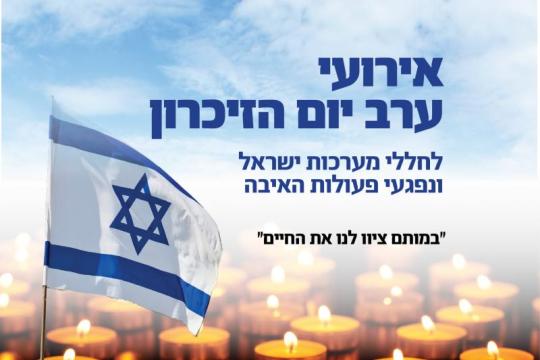
On this Erev Yom Ha'Shoah, I'd like to share with you some data, published on Thursday by Israel's Central Bureau for Statistics (source in Hebrew).
The number of Jews worldwide is 15.7 million, still lower than it was in 1939, before the Holocaust, 85 years ago (that is what a genocide looks like demographically).
7.1 million Jews live in Israel (45% of world Jewry) 6.3 million Jews live in the US (40% of world Jewry)
Here's the data for the top 9 Jewish communities in the world:
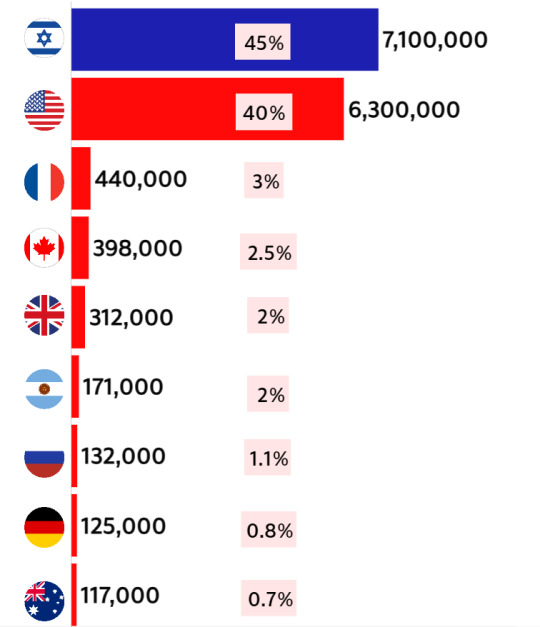
There are about 133,000 Holocaust survivors currently living in Israel. Most (80%) live in big cities in central Israel. Around 1,500 are still evacuated from their homes in northern and southern Israel due to the war (back in January, on International Holocaust Remembrance Day, there was a report about 1,894 survivors who also became internal refugees due to the war. Source in Hebrew). One Holocaust survivor, 86 years old Shlomo Mansour, is still held hostage in Gaza. He survived the Farhud in Iraq.
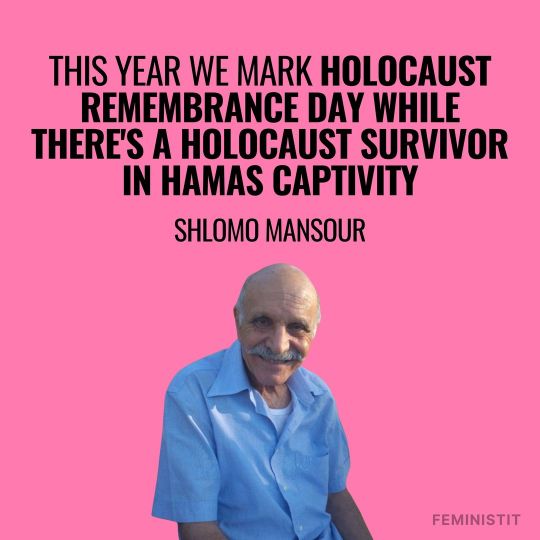
I haven't seen any official number for how many survivors had been slaughtered as a part of Hamas' massacre, despite everyone here being aware that Holocaust survivors had been murdered on Oct 7, such as 91 years old Moshe Ridler. Maybe, as we're still discovering that some people thought to have been kidnapped during the massacre, were actually killed on that day, no one wants to give a "final" number while Shlomo has not yet been returned alive.
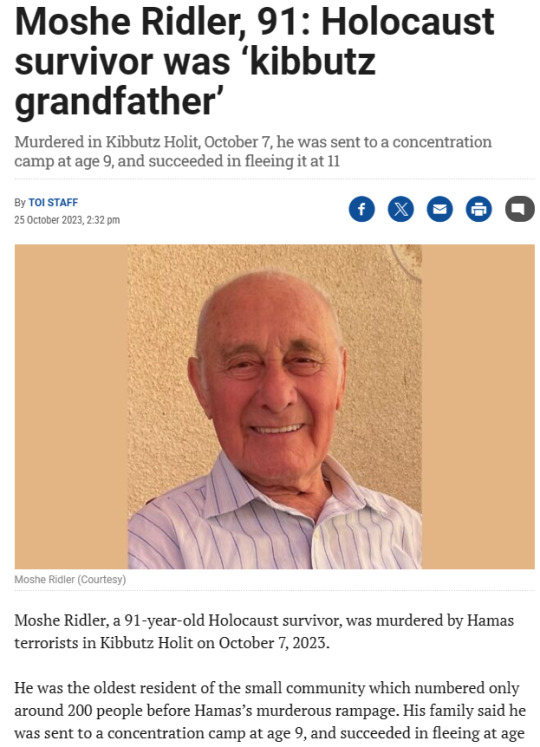
Out of all Israeli Holocaust survivors, 61.1% were born in Europe (35.8% in the countries of the former Soviet Union, 10.8% in Romania, 4.9% in Poland, 2.9% in Bulgaria, 1.5% in Germany and Austria, 1.3% in Hungary, 4.2% in the rest of Europe), 36.6% were born in Asia or Africa (16.5% in Morocco, 10.9% in Iraq, 4% in Tunisia, 2.6% in Libya, 2.1% in Algeria, 0.5% in other Asian and African countries) and 2.3% were born elsewhere.
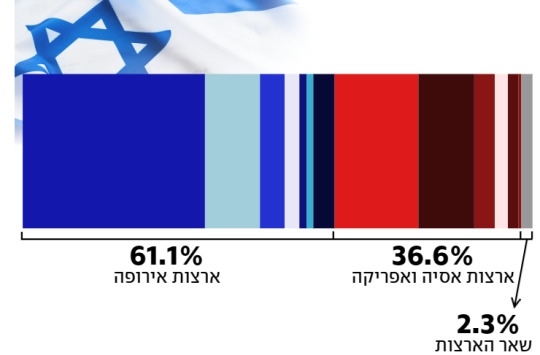
Out of all Holocaust survivors in Israel, 6.2% managed to make it here before the establishment of the state, despite the British Mandate's immigration policy against it (up until May 13, 1948). 30.5% made it to Israel during its very first years (May 14, 1948 until 1951), another 29.8% arrived in the following decades (1952-1989), and 33.5% made Aliyah once the Soviet Union collapsed, and Jewish immigration to the west (which included Israel) was no longer prohibited by the Soviet regimes (1990 on).
The second biggest community of survivors in the world is in the US, the third biggest (but second biggest relative to the size of the population) is in Australia. I heard from many Holocaust survivors who chose to immigrate there that they wanted to get "as physically far away from Europe as possible."
For a few years now, there's been this project in Israel, called Maalim Zikaron, מעלים זיכרון (uploading memory. Here's the project's site in Hebrew. In English it's called Sharing Memories, and here's the English version of the site) where Israeli celebs are asked to meet up with a Holocaust survivor (it's done in Hebrew), and share the survivor's story and the meeting on their social media on Erev Yom Ha'Shoah (which is today). Each year, there's also one non-Israeli Jewish celeb asked to participate (in English. This time around it's Michael Rapaport, he's meeting Aliza, an 81 years old survivor from the Netherlands, who was hidden along with 9 other Jewish babies for two years. He uploaded a preview of his meeting with her here, where he asked her what it means to her to be a Jew, and from what I understand, he will upload more today to the same IG account). This year, there will be an emphasis on Holocaust survivors who also survived Oct 7 (with 6 of the 20 participating survivors having survived Hamas as well). Here's a small bit from an interview with one such survivor, 90 years old Daniel Luz from kibbutz Be'eri:
(for all of my updates and ask replies regarding Israel, click here)
#israel#antisemitism#israeli#israel news#israel under attack#israel under fire#terrorism#anti terrorism#hamas#antisemitic#antisemites#jews#jew#judaism#jumblr#frumblr#jewish#israelunderattack#shoah#holocaust
467 notes
·
View notes
Note
Hi Dema!! Your art is fantastic and even the lineart is awesome! Solid and confident in where it's thick and where thin. I really like how your style has characters look more realistic and they have specific consistent features. Your blog has a pleasant atmosphere, and you're skilled in weaving AUs! There's a lot of details and structure, and I'd like to ask if any of them have a full story arc? Could you do a list of all of the AUs? Is there a motif that you especially like that repeats in any of the AUs? And whenever you add comments to my stuff in the tags I literally smile, it makes me want to keep at my plan to create everything I have in mind. So I'd like to spread this joy! I hope you have a nice day! (from late-draft ^^)
Hello, Late-Draft! I wasn't expecting this ask at all but I'm so glad to have received it!
First of all—I'll try to hold myself back from giggling like a schoolgirl. I'm having a sempai noticed me moment over here and that's just embarrassing. So give me a second to compose myself, if that's alright?
Okay, I'm back.
Now, on to business.
Character design, especially when it comes to facial features and how they're unique to each person, has always been a passion of mine. I always try to have a solid design for each character. I choose which features feel like the character in question, which face feels natural to draw, and go along with it. I love drawing Katara as much as I love drawing Zuko. Meanwhile, I seem to be on a never-ending battle against Sokka's features. Woes of an artist, I suppose.
Character design is actually one of the reasons I love your work so much, in case you hadn't noticed. I'm currently experimenting a bit with a different style... Hopefully it won't be long before the artwork is done and I can share it over here. I'm so excited for everyone to see it!
Now it's time for the reason we're all here.
I have said it before and shall say it once more: AUs are my lifeblood.
I love them so much! Building them, daydreaming the scenes, thinking of the characters and how they differ from their canon versions. The arcs and the themes and the worldbuilding. Building AUs is my passion, and I have so many of them!
There are a lot of motifs and themes that tend to repeat themselves in several of my AUs, I believe.
You'll notice that most of my stories are Zuko-centric, with a heavy emphasis on grief and humanity. There's the question of what makes us human and how to move forward when the whole world seems to push you back. I put a lot of stock in metaphors and symbolism within the narrative itself. I'm especially interested in the nuance of war and how it affects people emotionally, physically, and psychologically
I also tend to reutilize some elements of the lore and/or worldbuilding! Such as the Painted Lady's backstory, or the existence of War Children within the ATLA universe.
Now, the list!
I think I'll start with my current project, if that's okay :)
For the Spirits (New Gods AU)
Zuko was a child when he met Agni. Then, the spirits started coming to him. Eyes hidden in the hallways, voices pleading for help, for recognition, for remembrance.
Zuko could see Agni. He could see the broken remains of a Great Spirit and the empty smiles of amnesiac ghosts.
And they could see him in return.
I've been working on this AU for a long time, but only now did I get the chance to start writing the fic (linked up there!). I'm extremely excited about FTS and where the story will lead us in the future, but I'll try not to spoil too much.
It's a Zuko-centric story, with a heavy emphasis on Spirits and humanity. I'd like to add a warning for depression/mental health issues.
To Hesitate (Lee & Kya AU)
As she watches Lee and Kya avoid each other's eyes from across the room, the phrase comes back to her, swift and silent:
"To hesitate is to lose."
.
As Song treats the victim of an unfortunate interaction with a rare poisonous flower, her day takes an unexpected turn when it becomes apparent that the old man's nephew and her assistant have history.
A vivid history.
The Lee & Kya AU is a vibe, a feeling. It's probably one of my oldest AUs out there as well as one of my dearest.
A classical Lee and Kya From The Tea Shop AU, full with wholesome fandom tropes such as: fake (but not really) dating, fake identities, Ba Sing Se shenanigans, vigilante stuff, White Lotus missions, Iroh is a great Uncle, Zuko is an awkward turtleduck, and, of course, the fluffiest fluff you'll ever see.
Other than that, Lee & Kya is probably one of the less plot-focused AUs I have. However, that doesn't mean that there aren't scenes I can't wait to write or a canon divergence or two where Zuko is concerned.
(I have another fic posted but I'll leave that one to the end. You asked for a full story arc and, oh boy, does Soundless deliver.)
Kintsugi AU
Closer to being canon-adjacent than canon-divergent, Kintsugi is yet another Zuko-centric AU (and are we not noticing a pattern over here?).
I'd love to explain it in depth, but I believe the caption of the artwork linked above does a better job at explaining than I ever will.
Kintsugi is the art of decorating your scars with pieces of Agni.
In the Fire Nation, the amount of golden marks are a sign of status. Only the Royal Family can afford to seal every single wound with Kintsugi. Such is the weight of this tradition that, among the ones with Agni's blood, it is the highest mark of dishonor to have a natural scar, for it proves you aren't worthy of the privilege.
After the Agni Kai, Ozai forbid Zuko's scar to be sealed with Kintsugi. The boy wasn't worth his title, his traditions or his pride. Zuko would be broken, but he wouldn't be beautiful. Not anymore.
(And sometimes it's easier to pretend he never was)
Kyoshi Warriors AU
One of my absolute favorites!
In this AU, Ursa took Zuko and Azula with her when she was banished, so they could start anew. With help from Iroh and the White Lotus, she managed to relocate her freshly burned eight-year-old child and her crying daughter to Kyoshi Island.
Years later, when Avatar Aang and his companions first arrive at Kyoshi Island, they're met by the Kyoshi Warriors and their leader, Noriko of pale skin and warm brown eyes.
The Gaang leave Kyoshi Island many weeks later with a new companion. And if Jian Li, with his war paint and his scar and his dual dao, gives the island that he has called home for so long one final, longing glance as they fly away on Appa, they pretend not to notice.
Hunters AU
We're starting to dwelve deep into dangerous waters!
This is a Katara Joins Zuko In His Quest To Find The Avatar AU, with a twist!
This AU was born as a writing experiment. What if we take Katara's character, and change one of her core characteristics? Katara, who looked up to the Avatar as a saviour figure, now blames him for leaving and allowing the Fire Nation to wage war on the world.
Then comes Zuko, a banished Prince with a crew full of traitors and his own agenda. Zuko wishes for nothing more than to dethrone his father and end the war. He is a White Lotus member, an honorable, driven young man, and he has a plan.
The catch? He needs to take the Avatar to his father if he wishes to regain his title and be able to rightfully take the throne. Oh, and he will deliver the Avatar to the Fire Lord—but nobody said it had to be in chains.
Halfblood AU
I watched Blue Eye Samurai a few months ago and it destroyed me. The idea of a half-blooded child dead set on getting revenge for their very existence stuck with me, and this AU was born.
Kanna made a life for herself in the Earth Kingdom after leaving the North. Katara was raised by her grandmother in a small village, being taught to hide her bending if she wanted to live peacefully in a place she was only half of. Her mother had died in childbirth. Her father, a nameless warrior from the Southern Water Tribe who had loved Kya and left her behind, didn't know of Katara's existence.
Katara took over Kanna's clinic after she passed away. Always taking care of others. Always suppressing her need to bend. Always wishing for more.
One day, he arrived. A half-child, just like her. But while she was of Water, he was a son of Agni. He was searching for the man who brought him to this world. The man who scarred him. The man whose face he couldn't recall, whose name he did not know. The man whose specter had chased his mother to her grave. The man who would die at his hand.
The answers were hidden in a small teashop deep within Ba Sing Se. Lee offered her a way out, and Katara took it.
Soundless (Uiscefhuaraithe)
Katara of the Southern Water Tribe has hands scarred by fire and great talent, though no teacher.
Zuko is a mute War Child, a herbalist and healer, and the Blue Spirit. He bears the mark of fire, and the scar of the blade that took away his voice.
The first time they met, the Blue Spirit had just saved her, tough not before her hands got burned. The second time they met, his name was Lee, and he was healing her.
They live in war and they will fight, if not for the world, then for themselves.
You asked for a full storyline, and I shall deliver!
Soundless is probably the only AU I have fully planned. Three-books, Azula redemption arc, role-reversals and all.
This AU has everything. From travelling through the Earth Kingdom together, to odd character team-ups that somehow manage to work, and a major goal/conflict to resolve.
Zuko and Katara must find their way to Omashu in an Earth Kingdom ravaged by war as they also grow to understand each other, themselves, and the world around them. They meet with new and old alliances, keep their ears open for rumors of the Avatar (They say he is an airbender, Lee. Do you truly belive that?), and do their best to always be two steps ahead of their pasts.
Meanwhile, both the Northern and Southern Water Tribes are searching for the runaway heiress, Aang must find his way alone on this new, hostile world, and Azula must face the revelation that, despite what her father has stated for the last two years (liar, he lied at her! Her! He lied he liedliedliedlied), her brother might just be alive.
I'm sorry for making this such a long answer! I just get very excited about these subjects and don't know when to stop. If you made it all the way down here: thank you again.
I hope you have a good day ❤️
#dema answers#zutara#atla#zuko#avatar the last airbender#katara#zutara au#for the spirits#new gods au#Spirit Touched Zuko#to hesitate#lee and kya from the tea shop au#lee and kya from the tea shop#soundless au#Soundless (Uiscefhuaraithe)#soundless#kintsugi au#halfblood au#kyoshi warrior ursa au#kyoshi warrior zuko#kyoshi warriors au#hunters au#Katara joins Zuko AU#There's another AU I didn't mention#It's set in Ba Sing Se and it's shhhh a secret#Thank you again for writing to me!#I love to share my AUs and stories and headcanons and general craziness#This took me like two hours or so to write#They were absolutely worth it
180 notes
·
View notes
Text
As the world marks 80 years since the liberation of Auschwitz, one of Germany’s most prominent Holocaust scholars says twisting the facts about the Nazi extermination of 6 million Jews is far more harmful than outright denial — and that such distortion is “a stepping stone from antisemitism into the mainstream.”
Kathrin Meyer, secretary-general of the International Holocaust Remembrance Alliance, or IHRA, said she considers Holocaust distortion particularly dangerous, especially as the number of survivors dwindles with each passing year. This week, when the world focuses on International Holocaust Remembrance Day, only 50 survivors took part in ceremonies at the Nazi death camp in Poland – down from 300 just five years ago.
“Obviously, it’s an insult to the victims, but it’s also a threat to our democracy because you will not find a single radical, anti-democratic, nationalistic, imperialistic group ideology that does not have a distorted view of the Holocaust,” Meyer said about distortions that are often disguised as differing opinions rather than outright lies.
Tracking Holocaust denial and distortion is part of its wider mandate to address “contemporary challenges related to the Holocaust and genocide of the Roma people,” according to its website.
One example Meyer offered is that of Russian President Vladimir Putin’s constant vilification of neighboring Ukraine as a “Nazi government” despite the fact that Ukraine’s Jewish president, Volodymyr Zelensky, was democratically elected.
“It’s always those who attack freedom, liberal views, diversity and pluralistic societies,” said Meyer, who is stepping down from her position after two decades. “They use Holocaust distortion for their political gain.”
Meyer, who is not Jewish, has led the Berlin-based IHRA as the definition of antisemitism it developed became a flashpoint in political debates.
While many Jewish groups and a number of governments and municipalities have adopted the definition as a useful tool in identifying and fighting antisemitism, some critics say it could stifle free speech by chilling or criminalizing legitimate criticism of Israeli policy.
Meyer recalled that it took IHRA three years to adopt a definition of antisemitism that satisfied all its members, which include 35 member states, eight observer countries and nine global partners including the United Nations, the European Union, UNESCO and the Claims Conference.
That definition, Meyer said, is now “one of the most important tools ever” in the fight against Jew hatred.
“Before the adoption of this definition, I was confronted time and again with statements like ‘Oh, in our country, there is no antisemitism.’ We don’t have this discussion any longer,” said Meyer. “We discuss what should and shouldn’t be considered antisemitism, but antisemitism as such is acknowledged as a problem in all our societies.”
IHRA defines antisemitism as having a “certain perception of Jews that may be expressed as hatred” toward them. That perception includes certain kinds of rhetoric and action aimed at Israel and its supporters — for example, denying Jews the right to self-determination or calling Israel a “racist endeavor.”
Proponents of the definition see those examples as an important response to events like the sharp rise in vandalism of synagogues and cemeteries, verbal and physical attacks against Jews and “anti-Zionist” incitement since the Oct. 7, 2023, invasion by Hamas and Israel’s subsequent war in Gaza.
“The events of Oct. 7 have tragically proven us right. There cannot be a debate on antisemitism without looking into the completely biased criticism of Israel that we often see,” Meyer said. “This dramatic increase in antisemitic incidents came right after the worst attack on Jews since the Holocaust. The fact that this didn’t lead to more solidarity but to more antisemitism shows how deep this hatred goes, and how irrational it often is.”
Meyer, 60, knows a thing or two about deep and irrational hatred of Jews — and about the power of pushing back against it. She was born and raised in Celle, a village in Lower Saxony, just a few kilometers from the infamous Bergen-Belsen concentration camp where Anne Frank died.
“This really picturesque little town, with these medieval houses and a castle, looks almost like a Disneyland film set. It wasn’t affected by the war. No bombings, no nothing,” she recalled. “I was born in 1964, only 19 years after World War II ended. But there was a big silence in my town about Bergen-Belsen.”
That silence extended to her own family, said Meyer, describing her “liberation” at facing the facts of what her country had done to the Jews.
“I was among the first Germans for whom the Holocaust was part of the school curriculum,” she said. “My mother’s side of the family was very much opposed to the Nazi system, but my grandmother on my father’s side was a very committed Nazi. I grew up with her views as well, and I’ve had to fight that my entire lifetime.”
Later on, she earned a master’s degree in educational science and a PhD in history from Berlin’s Technical University, specializing in denazification and reeducation in Germany after 1945.
“For me, it was liberating to face the facts, to step up to the responsibility I have as a German of this generation — and to not shy away from it,” she said.
IHRA was founded as a temporary task force by then-Swedish Prime Minister Goran Persson. Along with Britain’s Tony Blair and U.S. President Bill Clinton, he organized a Stockholm forum held 25 years ago — on Jan. 27, 2000, that was attended by 46 heads of state and foreign ministers. There, they signed the Stockholm Declaration and committed their countries to support Holocaust education remembrance and research.
“That was revolutionary, because until then, it was mainly Jewish organizations that had commemorated the Holocaust, but it was never really seen as a governmental responsibility,” she said. “This is where we started. We had very few member countries at that point, but the others were invited. The snowball effect started, and soon it became an international institution with 35 member countries and global impact.”
Besides Jewish victims, IHRA also advocates on behalf of the Roma people, the minority ethnic group which Meyer said “are definitely the most discriminated group in Europe when it comes to hate crimes on a daily level.”
During World War II, the Nazis operated a concentration camp near Prague specifically for slaughtering the Roma. For years after the war, Czech farmers used the camp as a pig pen. Eventually, local authorities erected a small memorial.
“However, when I visited this place in 2016, I was astonished,” she said. “You see these plaques and rebuilt barracks, and some references to the Roma community that was destroyed, and then in the background, you hear these pigs screaming and you smell ammonia. It was so terrible.”
Thanks to IHRA’s then-president, Romanian diplomat Mihnea Constantinescu, Czech authorities moved the pig farm elsewhere and constructed a proper memorial site.
One of Meyer’s biggest concerns is the immense power of Big Tech, she said, citing “the problems we face just with Meta getting rid of fact-checking” on Facebook, and the increasing virulent hate speech spread on platforms like Instagram, TikTok and YouTube.
A recent UNESCO study of 4,000 pieces of content collected in June and July 2021 showed that 10% of such content on Facebook, 15% on Twitter (now X) and nearly half on Telegram either denied or distorted Holocaust history.
“These tech giants do whatever they want, and I have the feeling this is so unbalanced. It’s something that worries me tremendously,” Meyer said, though she’s not necessarily concerned that artificial intelligence will worsen those problems.
“There’s no question AI brings huge risks, but it also brings great opportunities, because AI cannot only be used by the bad guys. It can be used by us too—for example, in keeping the memory of survivors alive,” she said. “It’s not a curse. It’s in our world, and we need to use it.”
Asked about her legacy, Meyer said she’s proud to have helped turn IHRA into a “global player” while putting Holocaust distortion on the agenda.
“Making that a major topic was definitely one of the big passions I brought to this job,” she said. “We live in a world of deep divisions within our societies, and since we’re a consensus-based organization, we need to keep the consensus alive to confront antisemitism, extremism, hate speech and the challenge posed by AI and social media. This is a huge challenge, but I think that’s also the only way to go.”
Meyer’s successor at IHRA is Michaela Küchler, a veteran German diplomat who chaired the organization in 2021, and who currently serves as Germany’s consul-general in Chennai, India.
“She brings the drive we need to move this organization ahead and to not shy away from challenges,” Meyer said of Küchler, adding that “after 20 years in this business, I need a break.”
59 notes
·
View notes
Text
International Holocaust Remembrance Day 2025
Monday, January 27th, is the 80th anniversary of the liberation of Auschwitz, the largest Nazi concentration and death camp located in Poland. On this day in 1945, Soviet troops from the 60th Army of the First Ukrainian Front opened the gates of Auschwitz and witnessed the horrors that had occurred there.
Memorial Day commemorates the victims of the Holocaust, during which one-third of the Jewish population—six million Jews—along with millions of others, were murdered by the Nazis, and victims of other genocides. This is a significant commemorative event held at the former concentration camp on International Holocaust Remembrance Day. This site was established by Nazi Germany in occupied Poland during World War II.
The music of Schindler’s List, composed by John Williams, is made unforgettable by Itzhak Perlman’s violin. Born in Tel Aviv in 1945, Perlman was already a renowned musician when, at the age of 48, he performed the iconic violin solos for the 1993 soundtrack. The theme music from Schindler's List by John Williams is often played on Holocaust Memorial Day and Remembrance Day.
This memory must be passed on to future generations. For the dead and the living, we must bear witness. We remember and we must never forget.
Never again! 🕯️
#InternationalHolocaust #RemembranceDay #80thanniversary #liberationAuschwitzBirkenau #schindlerslisttheme #johnwilliamsmusic #storybehindthemusic #HolocaustMemorialDay #Filmsguild #Schindler'sList #ItzhakPerlman #LiamNeeson #NeverForget #NeverAgain#WWII
🎥 Schindler’s List
Posted 27th January 2025

@ aria-diary This is not forgotten because was part of the Generalplan Ost - GPO (General Plan East), a plan devised by Nazi leaders in 1941--1942 to resettle Eastern Europe with Germans, and move "inferior" groups within the Nazis' domain.
Nazi Germany's plan for extermination and large-scale ethnic cleansing of Eastern European Jews, Slavs, and other peoples of Eastern Europe categorised as "Untermenschen" (refer non-Aryan people they deemed as inferior) Nazi ideology - was mainly used against "the masses from the East", that is Jews, Roma, and Slavs (mainly ethnic Poles, Belarusians, Czechs, Ukrainians, Russians and Serbs). The territories involved included the occupied Poland, the Baltic states (Lithuania, Latvia, and Estonia), Belorussia, and parts of Russia and Ukraine.
During the war, many of the Nazis' activities were carried out with General Plan Ost in mind. They massacred millions of Jews in Eastern Europe,in addition to millions of Soviet prisoners of war. Millions more were sent to Germany to do forced labour.

The United Nations General Assembly Resolution 60/7, passed in 2005, designated January 27th as the International Day of Commemoration in memory of the victims of the Holocaust.
This date marks the anniversary of the liberation of Auschwitz-Birkenau, where more than 7,000 prisoners were freed. It is estimated that approximately 1.1 million people perished at Auschwitz during its five years of operation.

The notorious “arbeit macht frei” "work makes you free" sign at Auschwitz
@ aria-diary, I understand your concern. The Holocaust is referred to as the Shoah in Hebrew. (Shoah “calamity” is the term that is preferred by the Jewish community, because ”Holocaust” means “sacrifice by fire”) the systematic murder of millions of Jews by the Nazi regime and their allies during World War II. This plan was known to the Nazis as "The Final Solution to the Jewish Problem" and took place between 1941 and 1945. The Final Solution marked the tragic culmination of the Holocaust.
Auschwitz's liberation is significant because it was the centre of the Nazi campaign to eradicate Europe's Jewish population through extermination camps, whose primary purpose was the mass murder of Jews. Nearly one million of those who perished there were killed by poison gas and their bodies were incinerated in crematoria. The Jewish people were the largest group persecuted by the Nazis, targeted based on racial and political grounds.
There were prisoners in Auschwitz from almost every country in Europe They included Albanians, Belgians, Danes, Dutch, Greeks, Hungarians, Italians, Latvians, Lithuanians, Luxembourgers, Norwegians, Romanians, Slovaks, Spaniards, and Swiss, also died there and were targeted for different reasons.
80 years after the liberation of Auschwitz, the full impact of these events is still not completely understood. The post-war public often seeks to move on from the trauma of war, and the media tends to favour stories that can be celebrated. However, it is essential to remember the Holocaust context "Not forgiving Not forgetting." This serves as a way to honour and remember the victims of the Holocaust.
43 notes
·
View notes
Text
“Lia Hess, chair of the board of the Estonian Summer Camp Society, said in an emailed statement to CBC News that the monument was installed by Estonian war veterans who came to Canada as refugees in the 1940s and 1950s.
"The Estonian and Jewish communities share a common hatred and disgust of all totalitarian and oppressive regimes," Hess said in her statement.
"The Estonian summer camp does not now and has never honoured Nazi collaborators and our children have never been indoctrinated into worshipping Nazi leaders as alleged."
She added that the campers also commemorate Black Ribbon Day, which is formally recognized by the European Union and Canada as a day of remembrance for victims of Stalinism and Nazism.
"Flowers were placed in remembrance at the base of this plaque, like one who grieves at a grave. We are remembering those that died and the importance of defending our independent country, language, traditions and customs," Hess's statement says.”
So definitely not indoctrination of children into worshipping Nazi leaders, just placing flowers at their monuments and teaching them about how great they and their beliefs were. Totally a different thing.
“Eva Plach, an associate professor of history at Wilfrid Laurier University, said that when the Swords Monument was erected decades ago, Estonia was still a part of the Soviet Union and its people were fighting for independence.
"What always needs to be remembered in this region is that kind of active military resistance to the Soviet Union often meant collaboration with Nazi Germany," Plach said, explaining how Rebane and Riipalu could have once been celebrated within the Estonian community while also being a part of the Nazi military.”
I wonder if there’s a word for someone who allies themselves with Nazis and works alongside them to further their goals.
“”After the Union of Soviet Socialist Republics (USSR) was formally dissolved as a sovereign state, Estonia, the Baltic States and other countries "were trying to rewrite or understand better" their Second World War histories, Plach said.
"They were looking for nationalist heroes. They were looking for feel-good nationalist stories, where it was really difficult to find those stories and it was complicated, too."”
That actually doesn’t seem very complicated at all. It in fact seems pretty straightforward that you’re not gonna look like anything but Nazis if you venerate your Nazi heritage.
Canada is full of shit like this. SS memorials in public cemeteries, summer camps where little kids can learn about their proud history as Nazi collaborators.
@allthecanadianpolitics
63 notes
·
View notes
Text
Never again is NOW
Today is International Holocaust Remembrance Day. On International Holocaust Remembrance Day, we mourn the 6 million Jews and the 500,000 Roma who were systematically genocided by the Nazis during World War II.
In the midst of this current global tidal wave of Jew-hate, we Jews say NEVER AGAIN. Never again is NOW.
youtube
And a reminder to non-Jews who might try to steal this phrase:
Never Again is a Jewish phrase. Period. It doesn’t belong to non-Jews.
Never Again refers to the Shoah, and to the THOUSANDS of years of violent Jew-hatred we have endured before then.
Never Again states that we Jews will NEVER AGAIN be slaughtered by the millions.
If you are a goy, and you use this phrase for any other purpose, you are engaging in cultural appropriation.
You are appropriating Jewish trauma and pain that IS NOT YOURS.
Unless you are willing to shoulder the burden of 3500+ years of Jewish history, you do NOT get to use this phrase.
If you steal Never Again for any other context, all you are doing is broadcasting that you are a Jew-hating bigot who engages in Holocaust Inversion.
And you can take your antisemitic bigotry and go fuck off into the sun.
.
Baruch ata Adonai, Eloheinu melech ha-olam, borei p’ri hagafen.
Baruch ata Adonai, Eloheinu melech ha-olam, asher kid’shanu b’mitzvotav v’ratza vanu, v’shabbat kod’sho b’ahava uv’ratzon hinchilanu, zikaron l’ma’aseh b’reishit. Ki hu yom t’chila l’mikra-ay kodesh, zaycher l’tziat mitzrayim. Ki vanu vacharta v’otanu kidashta mikol ha’amim. V’shabbat kod-shi-cha b’ahava uv’ratzon hinchal tanu. Baruch ata Adonai, mi’kadesh ha Shabbat.
.
Feel this, to all those races, colors, and creeds, every man bleeds
For the countless victims and all the families of the murdered, tortured, enslaved
Raped, robbed and persecuted — Never Again
To the men, women, and children who died in their struggle to live
Never to be forgotten, Reuven Ben Menachem, yo…
.
My own blood dragged through the mud
Perished in my heart, still cherished and loved
Stripped of our pride, everything we lived for
Families cried, there's nowhere to run to, nowhere to hide
Tossed to the side, access denied
6 million died, for what?
.
Yo, a man shot dead in his back
Helpless women and children under constant attack
For no reason 'til the next season and we still bleeding
Yo it's freezing and men burn in Hell, some for squeezing
No hope for a remedy, nothing to believe
Moving targets who walk with the star on their sleeve
Forever marked with a number tattooed to your body
Late night, eyes closed, clutched to my shotty
Having visions, flashes of death camps and prisons
No provisions, deceived by the Devil's decisions
Forced into a slave, death before dishonor
For those men who were brave, shot and sent to their grave
Can't awaken, it's too late, everything's been taken
I'm shaken, family, history in the making
.
Never again shall we march like sheep to the slaughter
Never again shall we sit and take orders
Stripped of our culture, robbed of our name
Raped of our freedom and thrown into the flames
Forced from our families, taken from our homes
Removed from our G-d then burned of our bones
Never again, never again, shall we march like sheep to the slaughter
Never again leave our sons and daughters
Stripped of our culture, robbed of our name
(Never again) Raped of our freedom and thrown into the flames
Forced from our families, taken from our homes
Removed from our G-d and everything we own (Never again)
.
Some fled through the rumors of wars
But most left for dead, few escaped to the shores
With just one loaf of bread, banished
Called in for questioning and vanished, never to be seen again
I can't express the pain, that was felt in the train
To Auschwitz, tears poured down like rain
Naked, face to face with the master race
Hatred, blood, and David, my heart belongs to God and stays sacred
Rabbis and priests, disabled individuals
The poor, the scholars — all labeled common criminals
Mass extermination, total annihilation
Shipped into the ghetto and prepared for liquidation
Tortured and starved, innocent experiments
Stripped down and carved up or gassed to death
The last hour, I smelled the flowers
Flashbacks of family then sent to the showers
Powerless, undressed, women with babies clumped tight to their chest — crying
Who would've guessed — dying
Another life lost, count the cost
Another body gas-burned and tossed in the Holocaust
.
Never again shall we march like sheep to the slaughter
Never again leave our sons and daughters
Stripped of our culture, robbed of our name
Raped of our freedom and thrown into the flames
Forced from our families, taken from our homes
Removed from our G-d and everything we own
Never again, never again, shall we march like sheep to the slaughter
Never again shall we sit and take orders
Stripped of our culture, robbed of our name
(Never again) Raped of our freedom and thrown into the flames
Forced from our families, taken from our homes
Removed from our G-d then burned of our bones (Never again)
.
Never Again. Never Again.
.
From the USA to Afghanistan
From Israel to Pakistan
From Iraq to Iran
To Russia, Poland, and France
From China over to Japan
Worldwide
Never Again
.
Shema Yisrael Adonai eloheinu Adonai ehad
.
FIRE!
*GUNSHOT*
#jumblr#jewish history#holocaust remembrance day#never again#never forget#never again is now#NOTE: I report and block antisemites. If any antisemites comment on this post you will be reported and blocked. You have been warned.#Youtube
10 notes
·
View notes
Text

Sometimes I am asked if I know 'the response to Auschwitz; I answer that not only do I not know it, but that I don't even know if a tragedy of this magnitude has a response.
Elie Wiesel
My mother arrived in Brussels in 1938 from a small town near Krakow. But strangely enough, in 1942 or 1943, she was taken back to Auschwitz, which was just 30 miles from where she grew up. Her parents died there and a lot of her family.
Chantal Akerman
The concentration camp at Auschwitz was liberated 80 years ago. Today is observed as Holocaust Remembrance Day. But we are in danger of forgetting the greatest industrial mass murder of human beings.
Auschwitz stands as a tragic reminder of the terrible potential man has for violence and inhumanity.
mod
Distorting the history of World War II, denying the crimes of genocide and the Holocaust as well as an instrumental use of Auschwitz to attain any given goal is tantamount to desecration of the memory of the victims whose ashes are scattered here.
Andrzej Duda
Welcome!
The International Auschwitz Committee is an association of Auschwitz survivors and their organizations. The International Auschwitz Committee unites organizations, foundations and Holocaust survivors from 19 countries. The office of the IAC is located in Berlin. The current president of the IAC is Auschwitz survivor Marian Turski, Warsaw.
2025

#auschwitz#antifascist#before 80 years#wikipedia#international#freedom#chantal akerman#elie wiesel#andrzej duda#The International Auschwitz Committee is an association of Auschwitz survivors#wwII#history#holocaust#remember#save our democracy#freedom of expression
7 notes
·
View notes
Text
GREENWOOD, Dist. – On the 102nd anniversary of the Tulsa Race Massacre, the Tulsa Community Remembrance Coalition honors unknown victims with a solemn soil collection ceremony at Standpipe Hill in the Historic Greenwood District. The gathered soil, collected from both Standpipe Hill and Oaklawn Cemetery, honors those whose lives were tragically lost during this dark and painful moment in history.
The exact number of victims who perished in the Tulsa Race Massacre of 1921 remains unknown. However, estimations range from 300 to upwards of 500. The event, which took place over a two-day period from May 31 to June 1, resulted in widespread destruction and loss of life in the Greenwood district of Tulsa, Oklahoma, also known as “Black Wall Street.” However, due to the chaotic nature of the massacre, the destruction of records, and a lack of comprehensive investigations, an accurate and final count of the victims has never been determined.
Recent efforts to uncover the full extent of the tragedy continue, including through forensic investigations and testimonies from survivors and their descendants.
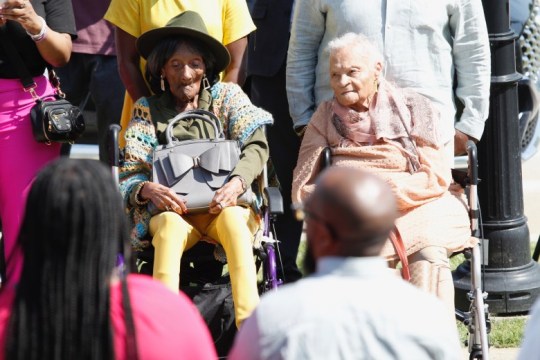
Greg Robinson, a member of the Tulsa Community Remembrance Coalition, emphasized the significance of gathering at Standpipe Hill. “It is amazing that we honor those unknown who were lost in the Tulsa Race Massacre. That we do it here on truly sacred ground – that actually represents the greatness of what Black Wall Street was, is and will be into the future,” Robinson shared. He then honored the American World War I veterans who lost their lives. “It is not lost on us that we honor veterans on this day as well,” Robinson added.
During the ceremony, Kristi Williams, a member of the Tulsa Remembrance Coalition and a descendant of the massacre, delivered a poignant reading. Through her words, she reminded everyone in attendance of the historical significance of the Tulsa Race Massacre and shed light on the countless victims whose identities have been lost to time, emphasizing the need to remember and honor them.
“Less than two dozen victims have been documented by name, but research has estimated that hundreds of Black men, women and children died in the massacre,” Williams sternly explained.
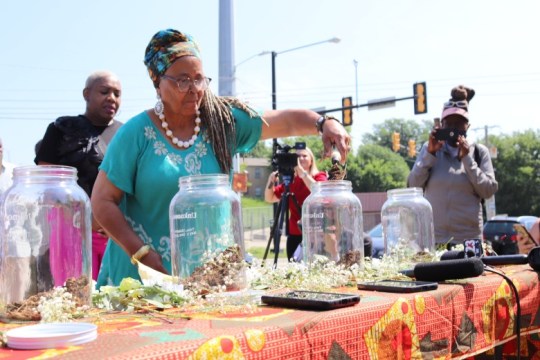
During Williams’ address, she shared an intriguing detail about the majestic hackberry tree standing tall on Standpipe Hill. She then revealed that this remarkable tree possesses a special ability to grow thick bark over the areas that were once damaged by fire, creating a protective shield against future harm, explaining that its resilient characteristic serves as a metaphor for the community’s ability to heal and endure in the face of adversity.
Williams proceeded to recount the heroic tale of Horace ‘Peg leg’ Taylor, a World War I veteran. She described how Taylor courageously positioned himself atop Standpipe Hill, wielding a gatling gun, and valiantly defended the hill for hours, providing a vital shield for the residents of Greenwood as they sought to escape from the violent White mob.
US Veteran Kenneth ‘K.Roc’ Brant, who works for the Terence Crutcher Foundation, shared a deeply personal reflection on the mental struggle he faced during the Centennial of the Massacre back in 2021.
He recounted the challenge of honoring both the victims of the Tulsa Race Massacre and the veterans during the centennial commemoration, which coincided with Memorial Day weekend.
“That weekend weighed heavily on me. [I was] torn as a Black military veteran and a Black man living in Tulsa,” Brant shared. At the ceremony, Brant recited a poem he wrote called “Holding Space” to express the thoughts and feelings he experienced. “This weekend, we remembered that some gave all. Here in Tulsa, we remembered that some took all. How do I hold space for both?” Brant said.
Brant’s individual story sheds light on the emotional and psychological battle he endured during his time in service and while navigating the complexities of what Black soldiers experienced during the Massacre upon their return to Tulsa after WWI.
#Honoring Unknown Victims of 1921 Tulsa Race Massacre#tulsa#white hate#race massacre#american white hate#Black Lives Matter#Tulsa race massacre
55 notes
·
View notes
Text
Rememberance Day 2024
Each year I like to take time out of my day on this day to refelct, mourn, and research on the fallen and forgotten soldiers that died in not only WWI but in any conflict. Today however, my scheduele has not allowed me to do so, barely being able to have a one minute silence. So instead, I thought I'd share this small post of commemoration; Lord Ares on my shoulder this time.
Remembrance Day is one of the most important days on our commemorative calendar. It's a day when we acknowledge those who died or suffered while serving in wars, conflicts and peace operations. Remembrance Day is held on 11 November each year. This is the anniversary of the Armistice of 1918 that ended fighting in World War I. The war didn't officially end until 28 June 1919 with the Treaty of Versailles. People in Australia and many other countries observe one minute's silence at the 11 th hour of the 11 th day of the 11 th month because that's when the Armistice came into effect. It's a time to honour our service personnel who died or suffered in service of Australia. - https://anzacportal.dva.gov.au/themes/custom/commemorations/favicon.ico
The Ode: "They shall grow not old as we who are left grow old: Age shall not weary them, nor the years condem. At the going down of the sun and in the morning We will remember them."
-'For the Fallen' [this verse is merely a section of the full poem, but this is what is most commonly said at events] Poem by Robert Laurence Binyon (1869-1943), published in The Times newspaper on 21 September 1914.
Read the full poem here:
https://www.army.gov.au/about-us/history-and-research/traditions/ode


My personal favourite Rememberance Day poem is the famous 'In Flanders Feilds' by John McCrae. It never ceases to make me cry (or at least tear up).
[excuse the poor spacing]
"In Flanders fields the poppies blow Between the crosses, row on row, That mark our place; and in the sky The larks, still bravely singing, fly Scarce heard amid the guns below. We are the Dead. Short days ago We lived, felt dawn, saw sunset glow, Loved and were loved, and now we lie, In Flanders fields. Take up our quarrel with the foe: To you from failing hands we throw The torch; be yours to hold it high. If ye break faith with us who die We shall not sleep, though poppies grow In Flanders fields."
This all being said, I wish everyone that lost someone dear to them in any war or conflict or act of violence is well and healing; and is allowing space to feel the emotions that come with grief.
I also believe it is a time to reflect upon ourselves and the present. Service people put themselves on the line for a better world, and they continue to, we should honour them. However, we should not need soldiers in the first place; although victims of war and violence do, the acts themselves hold no space in my heart. No oil, land, profit, business, religion, sexuality, race, gender, or anything should result in mass amounts of senseless violence, because well, it's just senseless. No innocent person deserves these attrocities.
My heart goes out to those in Gaza / Palestine, in Congo, in Lebannon, and in all other places where war, conflict, slavery, and discrimination is rife. This now too includes America since the recent election results.
Although donations and volunteer work is AMAZING. Being just an advocate or sharing information is essential as well and helps just as much; it spread it to the people who CAN make those big world decisions, it spread it to people who CAN donate, who CAN volunteer. So even if you can give money or too much time, which neither can I, please just spend even a few minutes to research or spread awareness, that too helps.
In conclusion; War sucks. It has no place in the world.
LEST WE FORGET
#rememberance day#poppy day#armistice day#remembrance day#helpol#australian#11th november#peace#lest we forget#the great war#support#gaza relief#sources#humanitarian#human rights#activism#hellenic pagan
3 notes
·
View notes
Text
6 million Jews were killed by the Nazis.
A narrative adopted by the Zionist movement and emphasized every year during Holocaust Remembrance.
The story of the Holocaust...
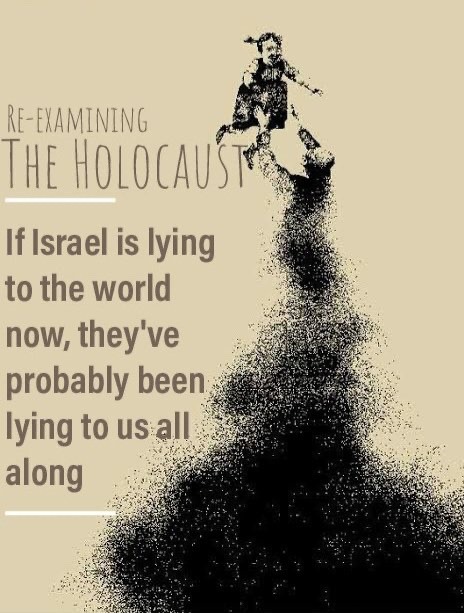
The word "Holocaust" is of Greek origin, meaning destruction by fire. It's used to describe the genocide the Jews suffered at the hands of the Nazis. Before the genocide,this term was used in Jewish religion to describe a sacrifice offered to God, completely consumed by fire.
More than 9 million Jews lived in Europe before World War II,residing in countries later controlled by the Nazis (Germany,Poland,Yugoslavia,Czechoslovakia & others). After the Holocaust,the Zionist movement claims that one in three Jews was killed. So,how and why did this happen?
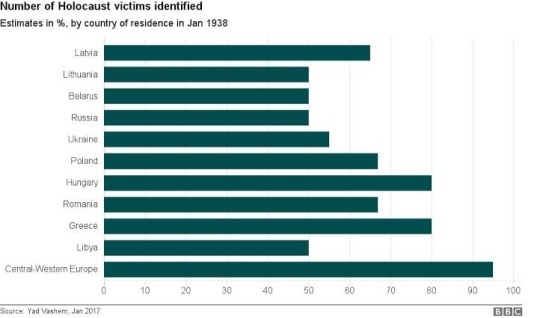
Let's go back a bit in history. After losing World War I,Germany faced poverty, despair & other heavy consequences. A party known as the Nazis emerged,gaining popularity by promoting two fundamental ideas
The first idea was the superiority of the Aryan race,the elite of nations..
The second was the establishment of a national state for the Germans, a sharp nationalist discourse evolving with the birth of the modern state, strengthened by the colonial European mindset that viewed African and Asian colonies as inferior.
In light of this, the Nazis targeted those they deemed subhuman, either due to their racial status or political non-acceptance. This means that the Jews were not the only victims of the conflict.
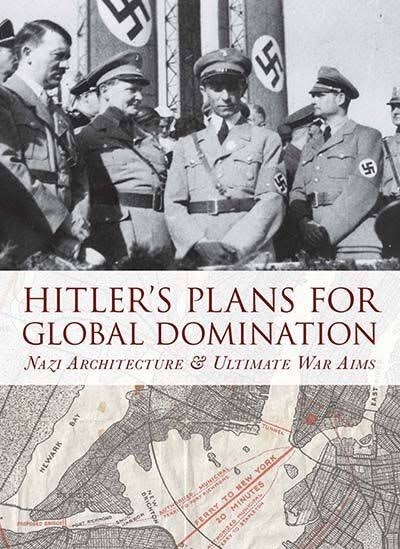
The Nazis also targeted Romani people, Slavic peoples, some Arabs, along with other groups like Communists, Socialists, trade unionists, homosexuals, and the disabled. By the way, among the victims were also Christian religious believers.
The Jews, along with others, faced systematic persecution policies leading to the "Final Solution" (extermination). Their books were burned, they were dismissed from jobs, their properties were confiscated, and they were uprooted from their homes to live in isolated ghettos.
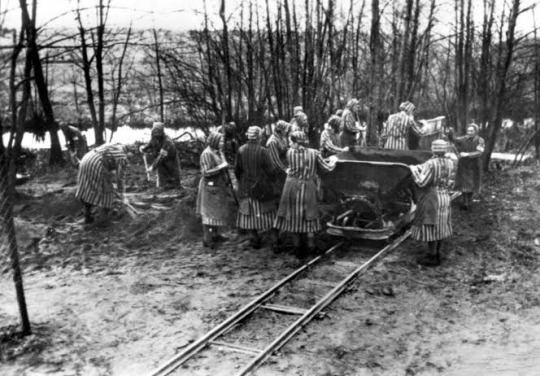
They were forced to wear a distinctive symbol on their clothes (the yellow Star of David) and were sent to concentration camps, subjected to forced labor until death.
The victims of the Nazis exceeded 20 million people, so why focus only on the Jews?
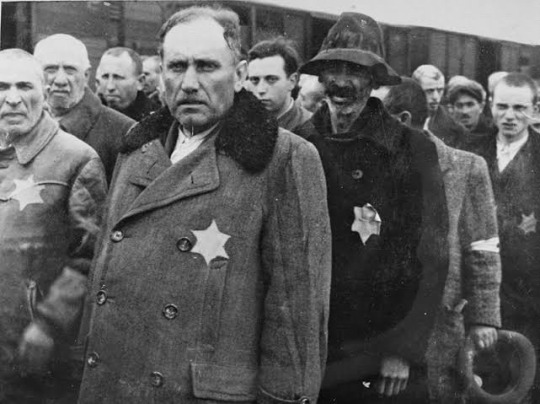
Jewish groups possessed financial resources, media institutions, research centers, and academic voices that shed more light on the victims of the Holocaust among the Jews. However, the number of Holocaust victims remains one of the most prominent historical debates to this day.
People are divided into groups: some deny the genocide, some believe the results are exaggerated, and some accuse the Zionist movement of exaggerating it for the benefit of the establishment of Israel. Here, let's pause. How did Israel benefit from the Holocaust?
During the initial months of Nazi rule, an agreement was signed between the Zionist Agency and Nazi Germany, aiming to facilitate Jewish migration to Palestine, provided they give up their assets to Germany. This is the only known official contract between the two parties.
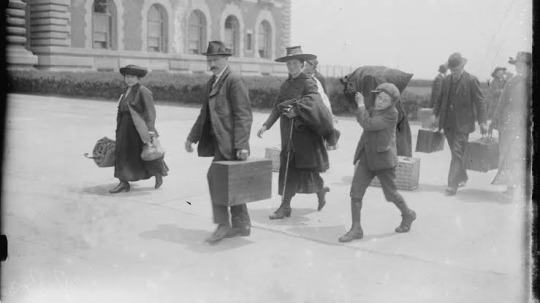
While it was later criticized by all sides, this agreement allowed more than 60,000 Jews to immigrate to Palestine early on and opened the door for similar migrations that greatly increased with the rise of Nazism, leading to the Nakba (Palestinian exodus).
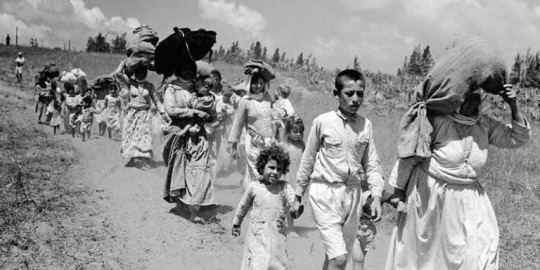
This agreement, along with other documents, led some to the idea that Hitler supported Zionism, prompting former Mayor of London, Ken Livingstone, to declare this belief openly, which eventually resulted in his suspension from the Labour Party in 2016.
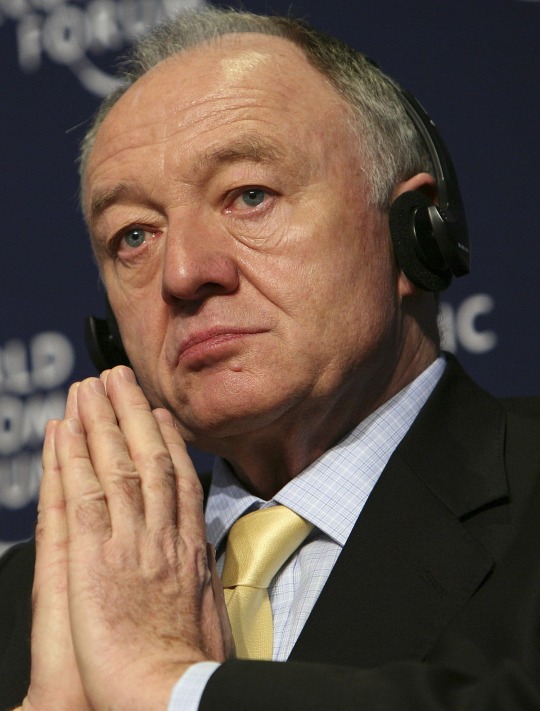
The Holocaust's narrative of persecution and suffering dominated the world, paving the way for Jewish migration to Palestine. But, did the story end like that?
After Germany's defeat in World War II, Axis countries, including Germany, were obligated to pay significant reparations to war-affected countries (Potsdam Conference, Paris Agreement). Later, Germany signed an agreement with Israel to compensate for ...
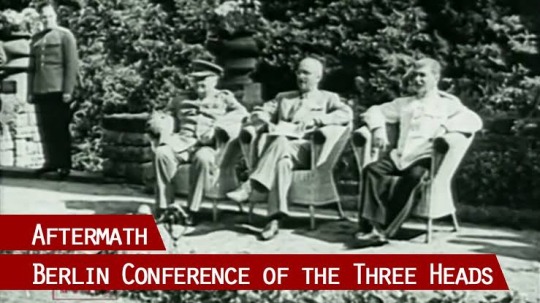
victims of racial persecution and Nazi victims, payable to the Israeli government and the World Jewish Congress.
Over six decades, Germany paid 89 billion dollars until 2012 as compensation to Nazi victims. Reparations were not only financial but also material
More dangerously, under the agreement, Germany became a major arms supplier to the Israeli state (1960-1970), helping Israel in a critical phase in the history of a newly born country.
Germany, which criminalized Holocaust denial in 1994 with the threat of imprisonment, still pays huge reparations for the consequences of World War II to a state that didn't exist when the genocide occurred.
Greeks, Serbs, Yugoslavs, as well as Roma people (Romani), all suffered, but German compensation to these victims doesn't match the payments to most Holocaust victims among the Jews.
The Holocaust, far from being a transient tragedy, continues to be a topic of denial. Dozens of large museums in various international capitals commemorate the tragedy, sparking global interest in the event, despite similar atrocities against other peoples.
Genocide of any people based on their race, gender, or religion is entirely rejected, warranting strong condemnation. Holocaust condemnation is a moral demand, but...
Israel, the biggest beneficiary of the Holocaust, uses Nazi ideologies as a basis for ethnic cleansing against Palestinians. The main ideology behind the establishment of Israel rests on religious, national, and geographic foundations, nurtured by Nazi ideologies.
People who have survived genocides or witnessed massacres are likely to experience PTSD when they encounter similar events .. but the case is totally different with zionist Israelis ..
This message was sent in an Israeli WhatsApp group after #jabalia massacre. DISGUSTING
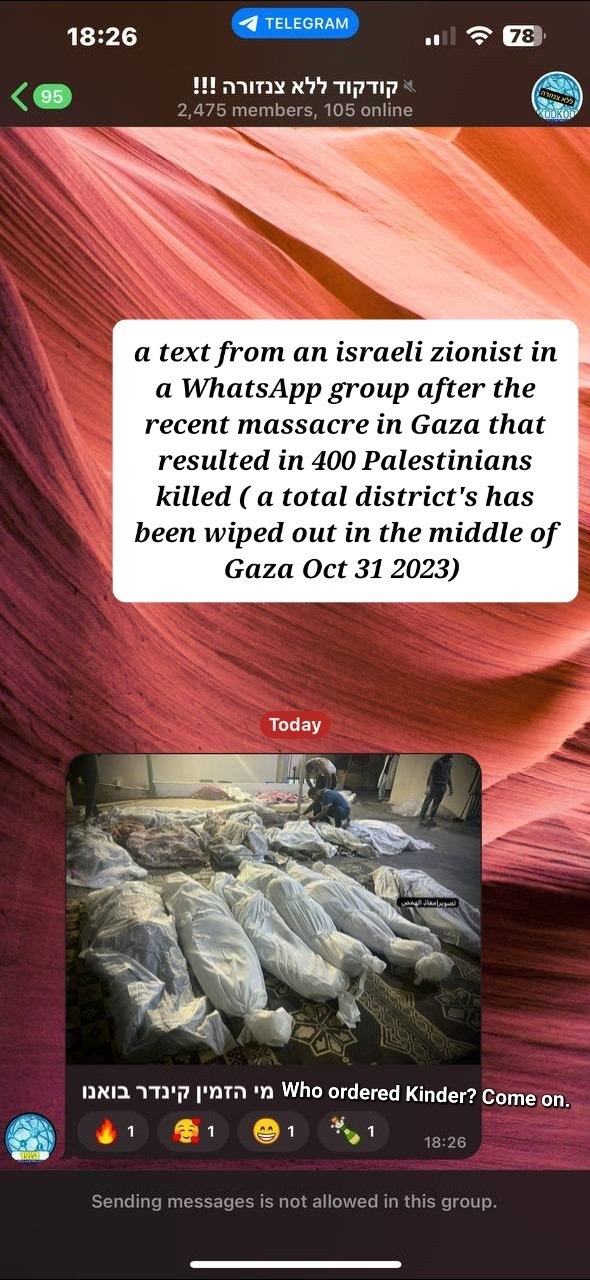
Here comes the most important question, amidst the lies spread by Israel during ongoing oppression.
How can we believe their narrative of the Holocaust ?
#gaza#free gaza#gaza strip#gaza news#gazagenocide#gazaunderfire#gazaunderattack#palestine#save gaza#stand with gaza#gazaunderatta#news on gaza#genocide#gaza under attack#gaza genocide#pray for gaza#is not real#israeli apartheid#pro israel#boycott israel#israel news#isreal#israel#palestinian#posts on palestine#palestinians
21 notes
·
View notes
Note
New follower of yours! Where may I find said Zutara fanfiction? (Thank you for your amazing art)
Welcome to the void, and thank you! I have a lot of AUs, but only some of those exist in fanfiction format. Links, info, and summaries to my fics under the cut!
For the Spirits
Rating: M
Chapters: 9/?
Words: 30, 172
Read here.
Zuko was a child when he met Agni. Then, the spirits started coming to him. Eyes hidden in the hallways, voices pleading for help, for recognition, for remembrance.
Zuko could see Agni. He could see the broken remains of a Great Spirit and the empty smiles of amnesiac ghosts.
And they could see him in return.
.
Imperfect Canvass
Rating: T
Chapters: 2/?
Words: 7, 427
Read here.
It's easy to forget, there, in Caldera. So they do everything in their power to remember. . The Blue Spirit and the Painted Ghost meet in the city each night, two souls in eternal search for repentance.
Katara tries to find a way to kill the war, whatever it takes. Zuko, the Perfect Prince, offers her the only pieces of him that remain.
.
Letters to Home
Rating: T
Chapters: 1/1
Words: 2, 494
Read here.
"Live," she pleads. "I don't want you to sacrifice yourself for this war—for me. I just need you to come back. Please...please come back to me." .
Zuko writes the letters whenever he can. During a break from a council meeting, late at night in his chambers, after another training session with Azula—all he does is write to her. Because he needs to let her know that he's alright and their plan is working. She needs to know that he'll come back.
.
To Hesitate
Rating: T
Chapters: 1/?
Words: 2, 136
Read here.
As she watches Lee and Kya avoid each other's eyes from across the room, the phrase comes back to her, swift and silent:
"To hesitate is to lose." .
As Song treats the victim of an unfortunate interaction with a rare poisonous flower, her day takes an unexpected turn when it becomes apparent that the old man's nephew and her assistant have history.
A vivid history.
.
Soundless (Uiscefhuaraithe)
Rating: M
Chapters: 1/?
Words: 2, 038
Read here.
Katara of the Southern Water Tribe has hands scarred by fire and great talent, though no teacher.
Zuko is a mute War Child, a herbalist and healer, and the Blue Spirit. He bears the mark of fire, and the scar of the blade that took away his voice.
The first time they met, the Blue Spirit had just saved her, though not before her hands got burned. The second time they met, his name was Lee, and he was healing her.
They live in war and they will fight, if not for the world, then for themselves.
#dema answers#atla#zutara#avatar the last airbender#atla fic#atla fanfic#zutara fic#zutara fanfiction
41 notes
·
View notes
Text
Holidays 1.27
Holidays
Apollo I Tragedy Day
Big Snow Day
Birth of Uncanny Conjectures Day
Cavadee (Mauritius)
Ceasefire Day (Vietnam War; 1973)
Day of Fatherland Defenders (Turkmenistan)
Day of the Lifting of the Siege of Leningrad (Russia)
Discovery Day (Antarctica)
e-Day
Electric Lamp Day
Everyones Unbirthday
Eugene Viollet-le-Duc Day
Family Literacy Day (Canada)
Fats Domino Day
Festival of Root Vibrations
International Day od Restorative Conservation
International Outer Space Day
Ka Moloka'i Makahiki (Molokai, Hawaii)
Kids & Vaccines Day (Canada)
Let There Be Light Day
Liberation of the Remaining Inmates of Auschwitz (a.k.a. ...
Auschwitz Day of Holocaust and Genocide Remembrance (Denmark)
Commemoration Day for the Victims of National Socialism (Tag des Gedenkens an die Opfer des Nationalsozialismus; Germany)
Day for Holocaust Remembrance and for the Prevention of Crimes against Humanity (Spain)
Day of Remembrance for Victims of Nazism
Day of Remembrance of the Holocaust and for the Prevention of Crimes against Humanity (Croatia)
Day of the Tragedy and Heroism of the Jews (Azerbaijan)
Dzien Pamieci Ofiar Nazizmu (The Memorial Day for the Victims of Nazism; Poland)
Holocaust Memorial Day (Luxembourg, Norway, UK, Ukraine)
Holocaust Remembrance Day (Estonia, Serbia, Slovenia, Sweden)
Holocaust Remembrance Day and the "Day of the Salvation of the Bulgarian Jews and of the Victims of the Holocaust and of the Crimes against Humanity" (Bulgaria)
Il Giorno della Memoria (Memorial Day; Italy)
International Day of Commemoration in Memory of the Victims of the Holocaust (Europe)
International Holocaust Remembrance Day (UN)
Memorial Day (Italy)
Memorial Day against Violence and Racism in Memory on the Victims of National Socialism (Austria)
Memorial Day for the Victims of National Socialism (Germany)
National Day of Commemorating he Holocaust (Romania)
National Holocaust Memorial Day (Greece, UK)
大屠殺陣亡將士紀念日 (Dà túshā zhènwáng jiàngshì jìniàn rì; Taiwan)
Lightbulb Day
Listen to Classical Music During Lunch Day
Mad Tea Party Day
Memorial Day of Purges (Finland)
Mézéréon Day (French Republic)
Mozart Day
National Activity Professionals Day
National Bible Day (Philippines)
National Boat Day (Australia)
National Costello Syndrome Awareness Day
National Heroes Day (Cayman Islands)
National Kazoo Day
National National Geographic Day
National Toilet Day (a.k.a. Thomas Crapper Day)
127 Day (South Korea)
Parent Mental Health Day (UK)
Perfect Fool Day
Public Employment Service Worker’s Day (Poland)
Punch the Clock Day
Rabbit Hole Day
SmallPitch Pitch Day
Spirituality Day (Monaco)
Thomas Crapper Day
Vietnam Peace Day (Vietnam)
Water Conservation Day
World Breast Pumping Day
World Day of Regional Anesthesia & Pain medicine
World Day Without Internet (Russia)
Food & Drink Celebrations
Brussels Lace Day
International Port Wine Day
National Chocolate Cake Day
Nature Celebrations
Rowan Day (Not Lazy; Korean Birth Flowers)
Independence, Flag & Related Days
Aysellant (Declared; 2011) [unrecognized]
Flag Day (Indonesia)
Greece (Declared; 1822)
Kingdom of Liahonia (Declared; 2020) [unrecognized]
New Year’s Days
Chinese New Year’s Eve Holiday
Get Holiday (Vietnam)
Seol-nal Holiday (South Korea)
4th & Last Monday in January
Aukland Day (New Zealand) [Monday closest to 29th]
Better Business Communication Day [4th Monday]
Blue Monday [Monday of Last Full Week]
Bubble Wrap Appreciation Day [Last Monday]
Community Manager Appreciation Day [4th Monday]
Cyber Monday (Russia) [Last Monday]
Meatless Monday [Last Monday of Each Month]
Meditation Monday [Every Monday]
Mellow Monday [4th Monday of Each Month]
Monday Musings [Every Monday]
Moody Monday [Last Monday of Each Month]
Motivation Monday [Every Monday]
Mushroom Monday [4th Monday of Each Month]
Nelson Day (New Zealand) [Monday closest to 29th]
Northland Anniversary Day (New Zealand) [Monday closest to 29th]
Weekly Holidays beginning January 27 (Last Week of January)
Farmhouse Breakfast Week (UK) [thru 1.31] (Last Week)
International Green Week
International Printing Week
Mozart Week
National Clean Out Your Inbox Week (thru 1.31)
National Cowboy Poetry Gathering Week (thru 2.1)
National Glaucoma Week
International Handwriting Analysis Week Week
National Medical Group Practice Week (thru 1.31) [M-F from 4th Monday]
Tax Identity Theft Week (thru 1.31) [M-F from 4th Monday]
Triangle Restaurant Week (Raleigh, North Carolina) [thru 2.2]
Festivals Beginning January 27, 2025
St. Moritz Gourmet Festival (St. Moritz, Switzerland) [thru 2.1]
Feast Days
Angela Merici (Christian; Virgin)
Arlene the Aardvark (Muppetism)
Свети Сава (St. Sava’s Day a.k.a. Spirituality Day; Serbia)
Chrysostom (Christian; Saint)
Day of Fatherland Defenders (Turkmenistan)
Day of Ishtar (Assyrian/Babylonian Goddess of Love; Everyday Wicca)
Day of the Dioscuri (Pagan)
Dévote’s Day (a.k.a. Devota; Christian; Saint) [Monaco]
Difficult People to Talk To Day (Celtic Book of Days)
Enrique de Ossó y Cercelló (Christian; Saint)
Feast Day of Thoth, the Magician’s Magician (Starza Pagan Book of Days)
Feast of Castor and Pollux (Ancient Rome)
Feast of the Translation of the Relics of Saint John Chrysostom (Christian)
Haroun-al-Raschid (Positivist; Saint)
Iroquois Mid-Winter Ceremony (Native American)
John Chrysostom (translation of relics) (Anglican, Lutheran, Eastern Orthodox)
Julian of Le Mans (Christian; Saint)
Llama Day (Pastafarian)
Lewis Carrol (Humanism; Writerism)
Lydia, Dorcas and Phoebe, Helpers of the Apostles (Lutheran)
Marius (Christian; Saint)
Michael Jackson Day (Church of the SubGenius; Saint)
Michiel van Musscher (Artology)
Mordecai Richler (Writerism)
Nino, Enlightener of Georgia (Christian; Saint)
Paul Joseph Nardini (Christian; Blessed)
Samaleswari Temple Inauguration (Odisha, India)
Sarkis the Warrior (Armenian Church)
Sava (Serbia)
Vitalian, pope (Christian; Saint)
Lunar Calendar Holidays
Chinese: Month 12 (Ding-Chou), Day 28 (Bing-Shen)
Day Pillar: Fire Monkey
12-Day Officers/12 Gods: Danger Day (危 Wei) [Auspicious]
Holidays: Chinese New Year’s Eve Holiday
Islamic Lunar Holidays
The Prophet’s Ascension (a.k.a. ...
Al Isra et Al Mirage (Djibouti)
Isra and Miraj (Kuwait)
Isra Mikraj (Brunei)
Isra’ Mi’raj Nabi Muhammed SAW (Indonesia)
Lailat al Miraj
Leilat al-Meiraj (Comoros)
Maha Shivaratri (South Africa, UK, US)
Miradji (Matotte)
The Prophet’s Ascension (West Bank and Gaza)
Secular Saints Days
Hendrick Avercamp (Art)
Mikhail Baryshnikov (Dance)
Bobby ‘Blue’ Bland (Music)
Lewis Carroll (Literature)
John Collier (Art)
Alan Cumming (Entertainment)
Bridget Fonda (Entertainment)
Jacques Hnizdovsky (Art)
Elmore James (Music)
Jerome Kern (Music)
Arkhip Kuindzhi (Art)
Peter Laird (Art)
Seison Maeda (Art)
Dmitri Mendeleev (Science)
Frank Miller (Art)
Wolfgang Amadeus Mozart (Music)
Ignacio Noé (Art)
Patton Oswalt (Entertainment)
Samuel Palmer (Art)
Donna Reed (Entertainment)
Mordecai Richler (Literature)
Cal Schenkel (Art)
Lucky & Unlucky Days
Fortunate Day (Pagan) [5 of 53]
Sakimake (先負 Japan) [Bad luck in the morning, good luck in the afternoon.]
Premieres
Africa Squeaks (WB LT Cartoon; 1940)
Animated Crosswords (Banner Cartoon; 1925)
Before Sunrise (Film; 1995)
Betty Boop’s Crazy Inventions (Fleischer Betty Boop Cartoon; 1933)
Billboard Frolics (WB MM Cartoon; 1936)
Billy Sunday’s Tabernacle (Hearst-Pathe News Cartoon; 1917)
Boris Godunov, by Modest Mussorgsky (Opera; 1874)
The Break of Day (Aesop’s Film Fable Cartoon; 1929)
Camping Out (Mickey Mouse Disney Cartoon; 1934)
The Castle, Franz Kafka (Novel; 1926)
The City and the Stars, by Arthur C. Clarke (Novel; 1956)
Customers Wanted (Fleischer Popeye Cartoon; 1939)
Draftee Daffy (WB LT Cartoon; 1945)
The Drowned World, by J.G. Ballard (Novel; 1962)
Elementary, My Dear [#2] (Multiplication Rock Cartoon; Schoolhouse Rock; 1973)
The Fighting 69th (Film; 1940)
The Flying Sorceress (Tom & Jerry Cartoon; 1956)
Fresh Laid Plans (Fun & Facts About America MGM Cartoon; 1951)
The Grey (Film; 2012)
Heartbreak Hotel, by Elvis Presley (Song; 1956)
How Green Is My Spinach (Fleischer/Famous Popeye Cartoon; 1950)
Instant Karma, written and recorded by John Lennon (Song; 1970)
Justice League: Throne of Atlantis (WB Animated Film; 2015)
Krazy’s Bear Tale (Krazy Kat Cartoon; 1939)
Last Tango in Paris (Film; 1973)
Laverne & Shirley (TV Series; 1976)
The Man, by Taylor Swift (Song; 2020)
Man on a Ledge (Film; 2012)
Mighty Hunters (WB MM Cartoon; 1940)
Misguided Missile (Woody Woodpecker Cartoon; 1958)
Mississippi Burning (Film; 1989)
Moondance, by Van Morrison (Album; 1970)
Mouse Trappers (Andy Panda Cartoon; 1941)
My Friend the Monkey (Betty Boop Cartoon; 1939)
Nanny McPhee (Film; 2006)
National Geographic Society (Adventure Club; 1888)
Nightwing and Robin (WB Animated Film; 2015)
One For the Money (Film; 2012)
One Gun Gary in Nick of Time (Terrytoons Cartoon; 1939)
Operation Paciific (Film; 1951)
Pettin’ in the Park (WB MM Cartoon; 1934)
Piano Sonata in B Minor, by Franz Liszt (Piano Sonata; 1857)
A Picture (Coca-Cola Ad UPA Cartoon; 1958)
The Police Dog on the Wire (Paramount-Bray Cartoon; 1916)
Resident Alien (TV Series; 2021)
Resident Evil: The Final Chapter (Film; 2017)
Rheumatics (Heasrt-Vitagraph News Pictorial Cartoon; 1918)
The Seeds of Time, by John Wyndham (Short Stories; 1956)
Shelby GT350 (Automobile; 1965)
Shōgun, by James Clavell (Novel; 1975)
Shrinking (TV Series; 2023)
Silkwood (Film; 1984)
Sittin’ On the Dock of the Bay, by Otis Redding (Song; 1968)
Soft Ball Game (Oswald the Lucky Rabbit Cartoon; 1936)
Spare the Child (Family Circus Fleischer Jolly Frolics Cartoon; 1955)
The Subterraneans, by Jack Kerouac (Novel; 1958)
Tom-ic Energy (Tom & Jerry Cartoon; 1965)
Toy Time (Aesop’s Sound Fable Cartoon; 1931)
Tumble Down Town (Aesop’s Sound Fable Cartoon; 1933)
The Turn of the Screw, by Henry James (Novel; 1898)
University of Georgia (School; 1801)
Wide Open Spaces, by The Dixie Chicks (Album; 1998)
Today’s Name Days
Angela, Julian (Austria)
Anđela, Anđelka, Julijan (Croatia)
Ingrid (Czech Republic)
Chrysostomus (Denmark)
Vilja, Vilje (Estonia)
Viljo (Finland)
Angèle (France)
Alrun, Angela, Gerd (Germany)
Chrysostomos (Greece)
Angelika (Hungary)
Angela, Elvira (Italy)
Ildze, Ilze, Izolde (Latvia)
Ilona, Jogundas, Jogundė, Natalis, Vytenis (Lithuania)
Gaute, Gry, Gurli (Norway)
Angelika, Ilona, Jan Chryzostom, Julian, Przybysław (Poland)
Ioan (Romania)
Nina (Russia)
Bohuš (Slovakia)
Ángela (Spain)
Göta, Göte (Sweden)
Buck, Buckley, Floyd, Keith, Lloyd, Logan (USA)
Today’s National Name Days
National Lloyd Day
Today is Also…
Day of Year: Day 27 of 2025; 338 days remaining in the year
ISO Week: Day 1 of Week 5 of 2025
Celtic Tree Calendar: Luis (Rowan) [Day 7 of 28]
Chinese: Month 12 (Ding-Chou), Day 28 (Bing-Shen)
Chinese Year of the: Dragon 4722 (until January 29, 2025) [Jia-Wu]
Coptic: 19 Tubah 1741
Druid Tree Calendar: Cypress (Jan 25-Feb 3) [Day 3 of 15]
Hebrew: 27 Teveth 5785
Islamic: 27 Rajab 1446
J Cal: 27 White; Sixthday [27 of 30]
Julian: 14 January 2025
Moon: 4%: Waning Crescent
Positivist: 27 Moses (1st Month) [Haroun-al-Raschid]
Runic Half Month: Elhaz (Elk) [Day 6 of 15]
Season: Winter (Day 38 of 90)
Week: 4th & Last Week of January
Zodiac:
Tropical (Typical) Zodiac: Aquarius (Day 8 of 30)
Sidereal Zodiac: Capricorn (Day 13 of 29)
Schmidt Zodiac: Capricorn (Day 2 of 27)
IAU Boundaries (Current) Zodiac: Capricorn (Day 8 of 28)
IAU Boundaries (1977) Zodiac: Capricornus (Day 9 of 28)
2 notes
·
View notes
Text
Holocaust Remembrance Day


International Holocaust Remembrance Day Holocaust Remembrance Day, an article with texts, images and quotes that is taken from an online exhibition and from an Italian English e-book (Free) made at school. What happened cannot be undone, but it can be prevented from happening again. Anne Frank Whoever listens to a survivor of the Holocaust becomes in his turn a witness. Elie Wiesel I will never forget that night, the first night in the camp, which made my life a long night and seven times barred. I will never forget that smoke. I will never forget the small faces of the children whose bodies I had seen transform into curls of smoke under a silent sky. I will never forget those flames that consumed my Faith forever. I will never forget that nocturnal silence that took away from me the desire to live for eternity. I will never forget those moments that murdered my God and my soul, and my dreams, which took on the face of the desert. I will never forget all this, even if I were condemned to live as long as God himself. Never. Elie Wiesel Cold-blooded murder and culture are not mutually exclusive. If the Holocaust has shown us anything, it's that a person can love poetry and still kill children. Elie Wiesel Take a stand. Neutrality always favors the oppressor, not the victim. Silence always encourages the torturer, never the tortured. Elie Wiesel A besieged city where people wander around like ghosts, students don't go to school and teachers have nothing to teach. People don't know where to meet: the night comes too early and the dawn too late. Elie Wiesel They wanted to kill the last Jew on the planet at any cost. Today we might ask: why memory, why remember, why inflict such pain? After all, it's late for the dead but not for the living. If the torment cannot be eliminated, one can instead hope, reflect, become aware. Elie Wiesel

Auschwitz concentration camp The belly is still pregnant with monsters. Do you see this filthy puppet? He was there to take over the world. The peoples have won the house painter and his whole regime has gone to the bottom. But now he doesn't rest on your laurels and don't just think about your own business. The womb he came out of, it is still pregnant with monsters. Bertolt Brecht It wasn’t Hitler or Himmler who deported me, beat me, killed my family. They were the milkman, the neighbor, the shoemaker, the doctor, who was given a uniform and believed that they were the superior race. Karel Stojka, survivor of Auschwitz Auschwitz was a tragedy. It was a tragedy that the world turned to the other way. But as a matter of fact it is, on many occasions, what still happens today. Carl William Brown "It did not start with the gas chambers. It did not start with the crematoria. It did not start with the concentration and extermination camps. It didn’t start with the 6 million Jews who lost their lives. Nor did it begin with the other 10 million people who died, including Poles, Ukrainians, Belarusians, Russians, Yugoslavs, Italians, the disabled, political dissidents, prisoners of war, Jehovah’s Witnesses and homosexuals. It began with politicians dividing people between "us" and "them". It began with speeches of hatred and intolerance, in the streets and through the media. It began with promises and propaganda, aimed only at increasing consensus. It began with laws that distinguished people by "race" and skin color. It began with the children expelled from school, because they were children of people of another religion. It began with people deprived of their possessions, their affections, their homes, their dignity. It began with the filing of intellectuals. It began with ghettoization and deportation. It began when people stopped caring, when people became numb, obedient and blind, with the belief that all this was "normal". “ Primo Levi Several years ago, on the occasion of the Day of Memory, within the artistic section of the Daimon Club, I published an online exhibition, with the support and photographic material of David Cirese, a photographer in Rome, professor at the Higher Institute of Photography of the same city, and Webmaster of Netart. After a few years an e-book retraces that event. The theme of this exhibition is of sure interest to everyone, today more than ever, starting from the world of education to get to that of politics and administration, passing through the reality of industry to arrive at that of art and literature.

Auschwitz in order not to forget I had chosen this topic to create the first online exhibition of the club because I have always written against the power and authority of stupidity and reminding me of the passion with which my teacher of Italian in middle school explained to me the resistance and the drama of the holocaust, when I saw David Cirese’s photographs on Auschwitz on the Internet, I realized that I should have done something and thus contribute to the preservation of memory and the dissemination of sacrosanct historical information. Carl William Brown Anti-Semitism. Pre-World War II Persecution of German Jews Holocaust (Greek holo, “whole”; caustos, “burned”), originally, a religious rite in which an offering was entirely consumed by fire. In current usage, holocaust refers to any widespread human disaster, but when written Holocaust, its special meaning is the almost complete destruction of the Jews in Europe by Nazi Germany. During the 19th century, European Jewry was being emancipated, and, in most European countries, Jews achieved some equality of status with non-Jews. Nonetheless, at times Jews were vilified and harassed by anti-Semitic groups. Indeed, some anti-Semites believed that Jewry was an alien “race” not assimilable into a European culture, but they did not formulate any coherent anti-Semitic campaign. (See also POGROM.) When the Nazi regime came to power in Germany in January 1933, it immediately began to take systematic measures against the Jews. One early decree was a definition of the term Jew. Crucial in that determination was the religion of one's grandparents. Anyone with three or four Jewish grandparents was automatically a Jew, regardless of whether that individual was a member of the Jewish community. Half-Jews were considered Jewish only if they themselves belonged to the Jewish religion or were married to a Jewish person. All other half-Jews, and persons who had one Jewish grandparent, were styled Mischlinge (half-breeds). Jews and Mischlinge were “non-Aryans.” In Nazi doctrine, such emphasis on descent was regarded as an affirmation of “race,” but the principal purpose of these categorizations was the clear delimitation of a target for discriminatory laws and directives.

Auschwitz in order not to forget The “Aryanization” of Businesses From 1933 to 1939, concerted efforts were made by the Nazi party, agencies of the government, banks, and business enterprises to eliminate Jews from economic life. Non-Aryans were dismissed from civil service positions, and Jewish lawyers and doctors lost their Aryan clients. Jewish firms were either liquidated and their inventory disposed of, or they were purchased for much less than their full value by companies that were not owned or operated by Jews. The contractual transfer of Jewish enterprises to new German owners was called “Aryanization.” The proceeds of any sales, as well as Jewish savings, were subjected to special property taxes. The Jewish employees of liquidated or Aryanized firms lost their jobs. The Night of Broken Glass The proclaimed objective of the Nazi regime was Jewish emigration. In November 1938, following the assassination of a German diplomat in Paris by a young Jew, all synagogues in Germany were set on fire, windows of Jewish shops were smashed, and thousands of Jews were arrested. This “Night of Broken Glass” (Kristallnacht) was a signal to Jews in Germany and Austria to leave as soon as possible. Several hundred thousand people were able to find refuge in other countries, but a similar number, including many who were old or poor, stayed to face an uncertain fate. The Occupation of Poland When World War II began in September 1939, the German army occupied the western half of Poland and thereby added almost 2 million Jews to the German power sphere. Restrictions placed on Polish Jewry were much harsher than those in Germany. The Polish Jews were forced to move into ghettos surrounded by walls and barbed wire. The ghettos were like captive city-states. Each ghetto had a Jewish council that was responsible for housing, sanitation, and production. Food and coal were to be shipped in and manufactured products sent out. The food supply allowed by the Germans, however, consisted mainly of grains and such vegetables as turnips, carrots, and beets. In the Warsaw ghetto, the official ration provided barely 1200 calories to each inhabitant. Some black-market food, smuggled into the ghettos, was sold at high prices, but unemployment and poverty were widespread. Housing was overcrowded, with six to seven people to a room, and typhus was common. Invasion of the USSR At the time of ghettoization in Poland, a drastic undertaking was launched farther to the east. In June 1941, German armies invaded the Union of Soviet Socialist Republics (USSR), and at the same time the Reich Security Main Office - an agency of the police and the Nazi party guard, known as the SS-dispatched 3000 men in special units to newly occupied Soviet territories to kill all Jews on the spot. These mobile detachments, known as Einsatzgruppen (action squads), were soon engaged in incessant shootings. The massacres usually took place in ditches or ravines near cities and towns. Occasionally, they were witnessed by soldiers or local residents. Before long, rumors of the killings were heard in several capitals of the world.

Auschwitz in order not to forget The “Final Solution” A month after the beginning of mobile operations in the occupied USSR, the second in command of Nazi Germany, Hermann Goring, sent a directive to the chief of the Reich Security Main Office, Reinhard Heydrich, charging him with the task of organizing a “final solution to the Jewish question” in all of German-dominated Europe. By September 1941, the Jews of Germany were forced to wear badges or armbands marked wth a yellow star. In the following months, tens of thousands were deported to ghettos in Poland and to cities wrested from the USSR. Even as that movement was under way, the stage was set for another innovation: the death camp. Concentration Camp Camps equipped with facilities for gassing people were erected on the soil of occupied Poland. Most prospective victims were to be deported to these killing centers from ghettos nearby. From the Warsaw ghetto alone, more than 300,000 were removed. The first transports were usually filled with women, children, or older men, who could not work; Jews capable of labor were retained in shops or plants, but they too were eventually killed. The heaviest deportations occurred in the summer and fall of 1942. The destinations of the transports were not disclosed to the Jewish communities, but reports of mass deaths eventually reached the surviving Jews, as well as the governments of the United States and Great Britain. In April 1943, the 65,000 remaining Jews of Warsaw offered resistance to German police who entered the ghetto in a final roundup. The battle was fought for three weeks. Deportations Throughout Europe, the deportations generated a host of political and administrative problems. In Germany itself, extensive discussions were held about the Mischlinge, and eventually they were exempted. In countries allied with Germany, such as the satellite states of Slovakia and Croatia, diplomatic negotiations were conducted to bring about deportations. The government of Vichy France, which had already extended its anti-Semitic laws, began imprisoning Jews before Germany's request to do so. The Italian Fascist government refused to cooperate with Nazi Germany until after Italy was occupied by German forces in September 1943, and the Hungarian government was similarly reluctant to give up its Jews until after German troops entered Hungary in March 1944. Although the Romanian government had been responsible for several large-scale massacres of Jews in the occupied USSR, Romania also declined to deliver its Jews to the Germans. In occupied Denmark, Danes from all walks of life resolved to save that country's Jews from certain death, ferrying thousands of them in small boats to neutral Sweden.

Auschwitz in order not to forget Wherever possible, the Germans collected the belongings of the deportees. In Germany, bank accounts and the contents of apartments were confiscated, and from occupied France, Belgium, and Holland (see NETHERLANDS) furniture was shipped to Germany for distribution to bombed-out persons. Transportation of victims to the death camps was generally by rail, and the police had to pay the German state railways a one-way third-class passenger fare for each deportee. When as many as 1000 persons were loaded on a train, a group rate that was half the normal tariff was allowed. The trains, consisting of freight cars, moved slowly on special schedules to their destinations. Often, the sick and the elderly died en route. The Death Camps The arrival points in Poland were Kulmhof (Chelmno), Belzec, Sobibor, Treblinka, Lublin (Maydanek), and Auschwitz (Oßwiécim). Kulmhof, northwest of the Lódz ghetto, was supplied with gas vans, and its death toll was 150,000. Belzec had carbon monoxide gas chambers in which 600,000 Jews, mostly from the populous Galician area, were killed. Sobibor's gas chambers accounted for 250,000 dead and Treblinka's for 700,000 to 800,000. At Lublin, some 50,000 were gassed or shot; in Auschwitz, the Jewish dead totaled more than 1 million. Auschwitz, near Kraków, was the largest death camp. Unlike the others, it used quick-working hydrogen cyanide for the gassings. The victims of Auschwitz came from all over Europe: Norway, France, the Low Countries, Italy, Germany, Czechoslovakia, Hungary, Poland, Yugoslavia, and Greece. A large inmate population, Jewish and non-Jewish, was employed by industry; some prisoners were subjected to medical experiments, particularly sterilizations. Although only Jews and Gypsies were gassed routinely, several hundred thousand other Auschwitz inmates died from starvation, disease, or shooting. To erase the traces of destruction, large crematories were constructed so that the bodies of the gassed could be incinerated. In 1944 the camp was photographed by Allied reconnaissance aircraft in search of industrial targets; its factories, but not its gas chambers, were bombed. Results of the Holocaust When the war ended, millions of Jews, Slavs, Gypsies, homosexuals, Jehovah's Witnesses, Communists, and others targeted by the Nazis, had died in the Holocaust. The Jewish dead numbered more than 5 million: about 3 million in killing centers and other camps, 1.4 million in shooting operations, and more than 600,000 in ghettos. (Traditional estimates are closer to 6 million.) Heavy pressure was placed on the victorious powers to establish a permanent haven in Palestine for Jewish survivors. The establishment of Israel three years after Germany's defeat was thus an aftereffect of the Holocaust. Raul Hilberg

Auschwitz in order not to forget Concentration Camp A prisonlike place created to confine selected groups of people, usually for political reasons. It differs from a regular prison in three ways: (1) men, women, and children are confined without normal judicial trials; (2) the period of confinement is indeterminate; and (3) camp authorities exercise unlimited, arbitrary power. Although many kinds of facilities have served as concentration camps, they usually consist of barracks, huts, or tents, surrounded by watchtowers and barbed wire. Concentration camps are also known by various other names such as corrective labor camps, relocation centers, and reception centers. Western Camps Modern concentration camps appeared at the end of the 19th century. The Spaniards used them in Cuba during the Spanish-American War (1898), and the British established them for thousands of women and children during the Boer War (1899-1902) in South Africa. In the West camps have been created several times during periods of war and national emergency. In France the government committed Spanish Republican refugees to reception centers in 1938 and added Jewish and other anti-Nazi refugees the following year. In Great Britain the government used Defense Regulation 18B in 1939 to send potentially disloyal citizens and refugees from enemy countries to internment camps. In the U.S., Executive Orders 9066 and 9102, later upheld by the Supreme Court, empowered the military to transport 70,000 U.S. citizens of Japanese descent and 42,000 Japanese resident aliens from the West Coast to relocation centers in the interior. Soviet Camps In Russia the Bolsheviks established concentration camps for suspected counterrevolutionaries in 1918. During the 1920s, “class enemies” and criminals were confined in the Northern Special Purpose Camps on the Solovetskiye Islands in the White Sea and near Arkhangelsk on the mainland. In the 1930s and '40s, a system of corrective labor camps covered most of the Soviet Union and received millions of prisoners in successive waves of mass arrests: independent farmers (kulaks); victims of the great purges; populations deported from the Polish and Baltic territories annexed in 1939; groups such as the Volga Germans considered potentially disloyal during World War II; Axis prisoners of war; and Russians returning from German captivity. Read the full article
#Concentration#Day#deportation#Deportations#e-book#Exibition#Hitler#Holocaust#Jews#memory#Remembrance#School#survivor#tragedy#WarII#world
2 notes
·
View notes
Text

A tweet from an American idiot who had no idea that Polish slavic people were deported to Auschwitz (a concentration camp created by Nazi Germany in 1940 specifically to intern Polish slavic people)…. Janina Nowak was born on 19th August 1917 in Będów, near Łódź, and was one of 31,000 Polish slavic women who the Germans deported to Auschwitz-Birkenau during the Second World War. She was registered at the camp on 12th June 1942 and received the prisoner number 7615. Less than two weeks later, on 24th June 1942, Nowak also became the first of 50 female prisoners who tried to escape from the camp. She fled while working near the Soła river as a member of a "Kommando" (work party) consisting of 200 Polish women.
She managed to reach Łódz (which was now called "Litzmannstadt", after being incorporated into the Third Reich) and managed to evade the German authorities until March 1943, when she was re-arrested.
On 8th May 1943, Nowak was brought to Auschwitz once again, where she received a new prisoner number - 31529. Later that year, she was transferred to Ravensbrück concentration camp, and was finally liberated in April 1945.
Not much is known about Nowak's post-war life. She died in 1999….
Like Łódz, Auschwitz was located in Polish territory that was annexed directly into the Third Reich after Nazi Germany invaded and occupied western Poland in 1939.
The Auschwitz concentration camp was established on Heinrich Himmler's orders in April 1940. Alongside Stutthof (opened in 1939) and Majdanek (opened in 1941), it was constructed initially to intern Polish slavic prisoners, who made up the majority of the inmates until 1942. The first transport of Polish prisoners to Auschwitz took place on 14th June 1940, and the Germans eventually deported at least 140,000 Polish slavic people to the camp, approximately half of whom did not survive.
Pursuant to a law passed by the Polish Parliament in 2006, the anniversary of the first mass transport to Auschwitz is now commemorated annually in Poland on 14th June, as the National Day of Remembrance of the Victims of German Nazi Concentration and Extermination Camps.
I sometimes think that the rabbit hole of American ignorance is so deep that you could probably use it to get from the USA to Australia….
#auschwitz#concentration camp#second world war#world war 2#germany#nazi germany#third reich#history#bad history take#bad history takes#ignorance#twitter#x
4 notes
·
View notes
Text
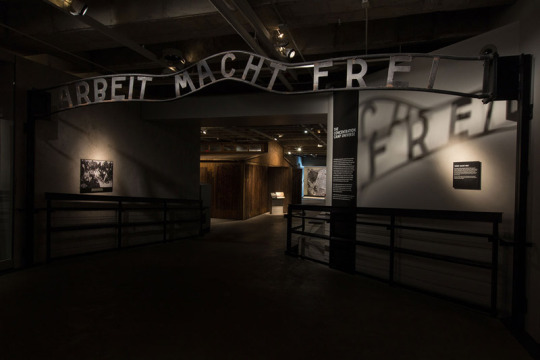
[Holocaust Museum]
* * * *
Powerful speech.
"This ancient hatred of Jews didn’t begin with the Holocaust; it didn’t end with the Holocaust, either, or after — or even after our victory in World War Two. This hatred continues to lie deep in the hearts of too many people in the world, and it requires our continued vigilance and outspokenness.
That hatred was brought to life on October 7th in 2023. On a sacred Jewish holiday, the terrorist group Hamas unleashed the deadliest day of the Jewish people since the Holocaust. "
REMARKS BY PRESIDENT BIDEN TODAY, AT THE U.S. HOLOCAUST MEMORIAL MUSEUM'S ANNUAL DAYS OF REMEMBRANCE CEREMONY:
"During these sacred Days of Remembrance, we grieve. We give voice to the 6 million Jews who were systematically targeted and murdered by the Nazis and their collaborators during World War Two. We honor the memory of victims, the pain of survivors, the bravery of heroes who stood up to Hitler’s unspeakable evil. And we recommit to heading and heeding the lessons that [of] one of the darkest chapters in human history, to revitalize and realize the responsibility of 'never again.'
Never again, simply translated for me, means 'never forget.' Never forget. Never forgetting means we must keep telling the story. We must keep teaching the truth. We must keep teaching our children and our grandchildren.
And the truth is we are at risk of people not knowing the truth.
That’s why, growing up, my dad taught me and my siblings about the horrors of the Shoah at our family dinner table. That’s why I visited Yad Vashem with my family as a senator, as vice president, and as president. And that’s why I took my grandchildren to Dachau, so they could see and bear witness to the perils of indifference, the complicity of silence in the face of evil that they knew was happening.
Germany, 1933. Hitler and his Nazi party rise to power by rekindling one of the world’s oldest forms of prejudice and hate: antisemitism. His rule didn’t begin with mass murder. It started slowly across economic, political, social, and cultural life: propaganda demonizing Jews; boycotts of Jewish businesses; synagogues defaced with swastikas; harassment of Jews in the street and in the schools; antisemitic demonstrations, pogroms, organized riots.
With the indifference of the world, Hitler knew he could expand his reign of terror by eliminating Jews from Germany, to annihilate Jews across Europe through genocide the Nazi’s called the 'Final Solution' — concentration camps, gas chambers, mass shootings.
By the time the war ended, 6 million Jews — one out of every three Jews in the entire world — were murdered.
This ancient hatred of Jews didn’t begin with the Holocaust; it didn’t end with the Holocaust, either, or after — or even after our victory in World War Two. This hatred continues to lie deep in the hearts of too many people in the world, and it requires our continued vigilance and outspokenness.
That hatred was brought to life on October 7th in 2023. On a sacred Jewish holiday, the terrorist group Hamas unleashed the deadliest day of the Jewish people since the Holocaust.
Driven by ancient desire to wipeout the Jewish people off the face of the Earth, over 1,200 innocent people — babies, parents, grandparents — slaughtered in their kibbutz, massacred at a musical festival, brutally raped, mutilated, and sexually assaulted. Thousands more carrying wounds, bullets, and shrapnel from the memory of that terrible day they endured. Hundreds taken hostage, including survivors of the Shoah.
Now, here we are, not 75 years later but just seven and a half months later, and people are already forgetting. They’re already forgetting that Hamas unleased this terror, that it was Hamas that brutalized Israelis, that it was Hamas who took and continues to hold hostages. I have not forgotten, nor have you, and we will not forget.
And as Jews around the world still cope with the atrocities and trauma of that day and its aftermath, we’ve seen a ferocious surge of antisemitism in America and around the world: vicious propaganda on social media, Jews forced to keep their — hide their kippahs under baseball hats, tuck their Jewish stars into their shirts.
On college campuses, Jewish students blocked, harassed, attacked while walking to class.
Antisemitism — antisemitic posters, slogans calling for the annihilation of Israel, the world’s only Jewish State.
Too many people denying, downplaying, rationalizing, ignoring the horrors of the Holocaust and October 7th, including Hamas’s appalling use of sexual violence to torture and terrorize Jews.
It’s absolutely despicable, and it must stop.
Silence — silence and denial can hide much, but it can erase nothing. Some injustices are so heinous, so horrific, so grievous, they cannot be muri- — buried, no matter how hard people try.
In my view, a major lesson of the Holocaust is, as mentioned earlier, it’s not — was not inevitable. We know hate never goes away; it only hides. And given a little oxygen, it comes out from under the rocks.
But we also know what stops hate. One thing: all of us.
The late Rabbi Jonathan Sacks described antisemitism as a virus that has survived and mutated over time. Together, we cannot continue to let that happen.
We have to remember our basic principles as a nation. We have an obligation — we have an obligation to learn the lessons of history so we don’t surrender our future to the horrors of the past. We must give hate no safe harbor against anyone — anyone.
From the very founding — our very founding, Jewish Americans, who represent only about 2 percent of the U.S. population, have helped lead the cause of freedom for everyone in our nation. From that experience, we know scapegoating and demonizing any minority is a threat to every minority and the very foundation of our democracy.
So, in moments like this, we have to put these principles that we’re talking about into action.
I understand people have strong beliefs and deep convictions about the world. In America, we respect and protect the fundamental right to free speech, to debate and disagree, to protest peacefully and make our voices heard.
I understand. That’s America.
But there is no place on any campus in America — any place in America — for antisemitism or hate speech or threats of violence of any kind — whether against Jews or anyone else.
Violent attacks, destroying property is not peaceful protest. It’s against the law. And we are not a lawless country. We’re a civil society. We uphold the rule of law.
And no one should have to hide or be brave just to be themselves.
To the Jewish community, I want you to know I see your fear, your hurt, and your pain.
Let me reassure you, as your President, you are not alone. You belong. You always have, and you always will.
And my commitment to the safety of the Jewish people, the security of Israel, and its right to exist as an independent Jewish state is ironclad, even when we disagree.
My administration is working around the clock to free remaining hostages, just as we have freed hostages already, and we will not rest until we bring them all home.
My administration, with our Second Gentleman’s leadership, has launched our nation’s first National Sec- — Strategy to Counter Antisemitism that’s mobilizing the full force of the federal government to protect Jewish communities.
But — but we know this is not the work of government alone or Jews alone. That’s why I’m calling on all Americans to stand united against antisemitism and hate in all its forms.
My dear friend, and he became a friend, the late Elie Wiesel, said, quote, “One person of integrity can make a difference.” We have to remember that now more than ever.
Here in Emancipation Hall in the U.S. Capitol, among the towering statues of history, is a bronze bust of Raoul Wallenberg. Born in Sweden as a Lutheran, he was a businessman and a diplomat. While stationed in Hungary during World War Two, he used diplomatic cover to hide and rescue about 100,000 Jews over a six-month period.
Among them was a 16-year-old Jewish boy who escaped a Nazi labor camp. After the war ended, that boy received a scholarship from the Hillel Foundation to study in America. He came to New York City penniless but determined to turn his pain into purpose, along with his wife, also a Holocaust survivor. He became a renowned economist and foreign policy thinker, eventually making his way to this very Capitol on the staff of a first-term senator.
That Jewish refugee was Tom Lantos, and that senator was me.
Tom and his wife, Annette, and their family became dear friends to me and my family. Tom would go on to become the only Holocaust survivor ever elected to Congress, where he became a leading voice on civil rights and human rights around the world.
Tom never met Raoul, who was taken prisoner by the Soviets, never to be heard from again. But through Tom’s efforts, Raoul’s bust is here in the Capitol.
He was also given honorary U.S. citizenship — only the second person ever, after Winston Churchill.
And the Holocaust Museum here in Washington is located on a roal- — a road in Raoul’s name.
The story of the power of a single person to put aside our differences, to see our common humanity, to stand up to hate. And it’s an ancient story of resilience from immense pain, persecution to find hope, purpose, and meaning in life we try to live and share with one another. That story endures.
Let me close with this. I know these Days of Remembrance fall on difficult times. But we all do well to remember these days also fall during the month we celebrate Jewish American heritage — a heritage that stretches from our earliest days to enrich every single part of American life today.
Great American — great Jewish American named Tom Lantos used the phrase, 'The veneer of civilization is paper thin. We are its guardians, and we can never rest.'
My fellow Americans, we must — we must be those guardians. We must never rest. We must rise against hate, meet across the divide, see our common humanity.
And God bless the victims and survivors of the Shoah.
May the resilient hearts, the courageous spirit, and the eternal flame of faith of the Jewish people forever shine their light on America and around the world, pray God.
Thank you all."
[Thanks Mikhail Iossel]
5 notes
·
View notes